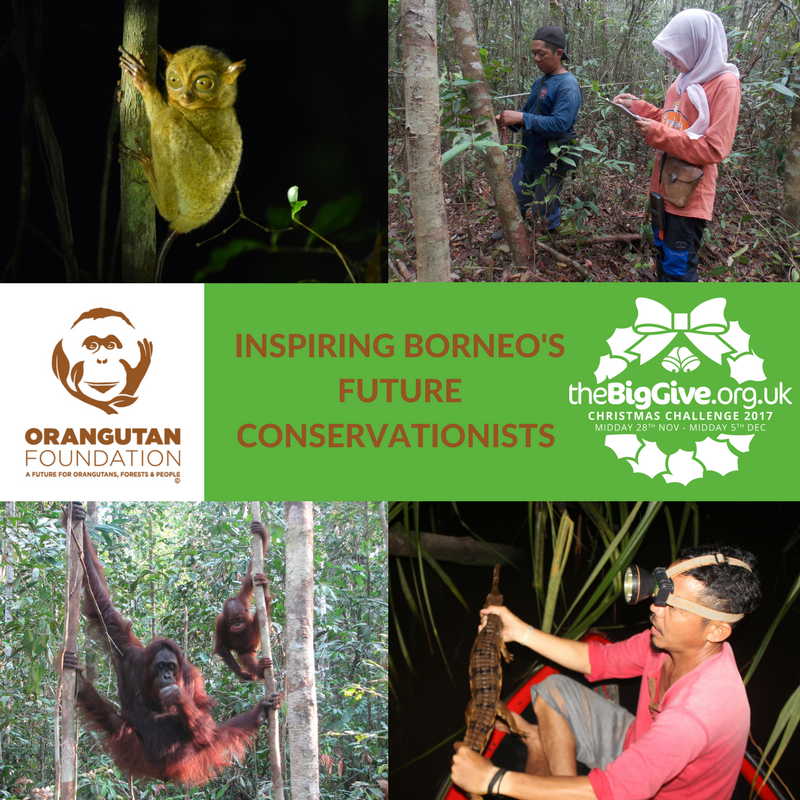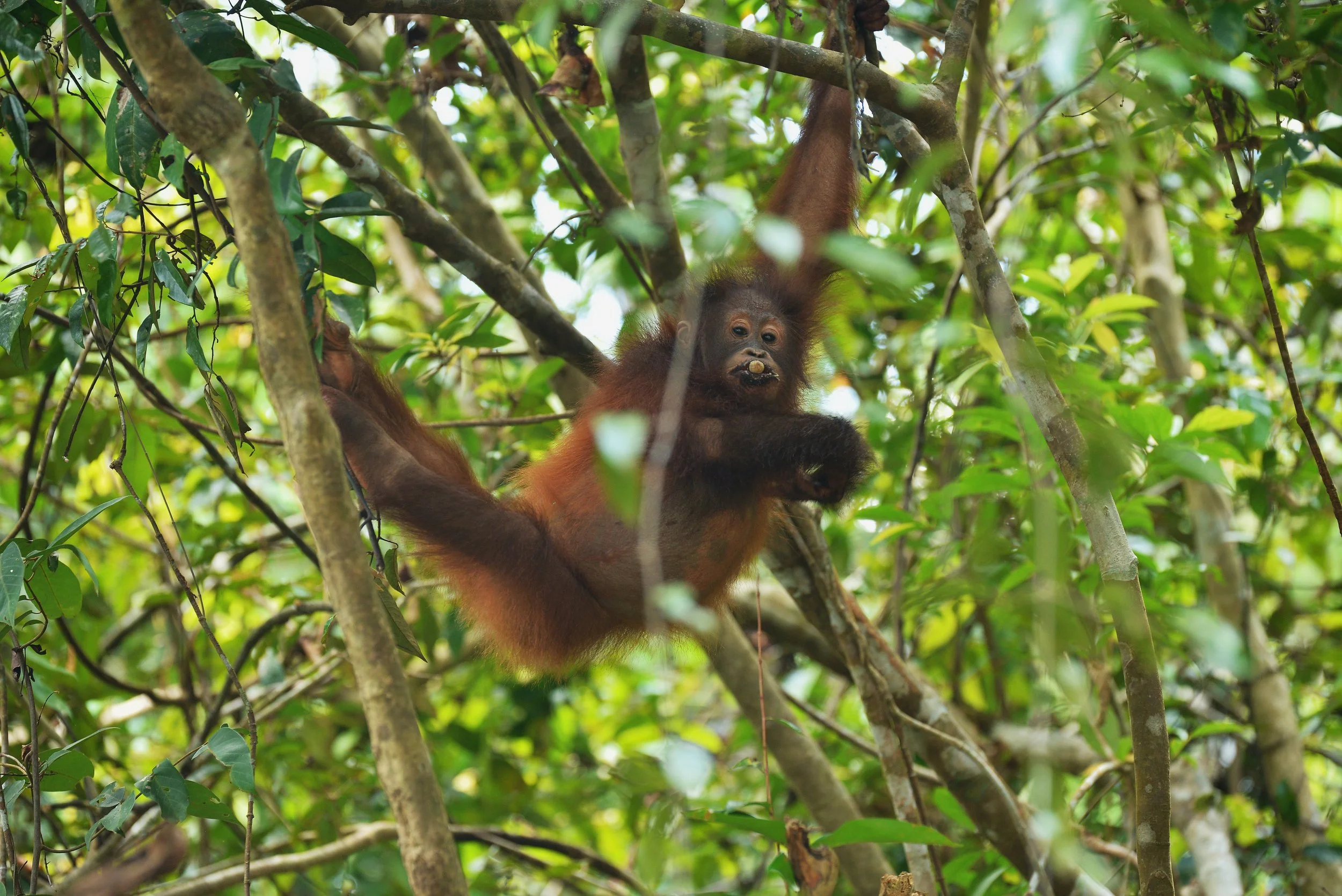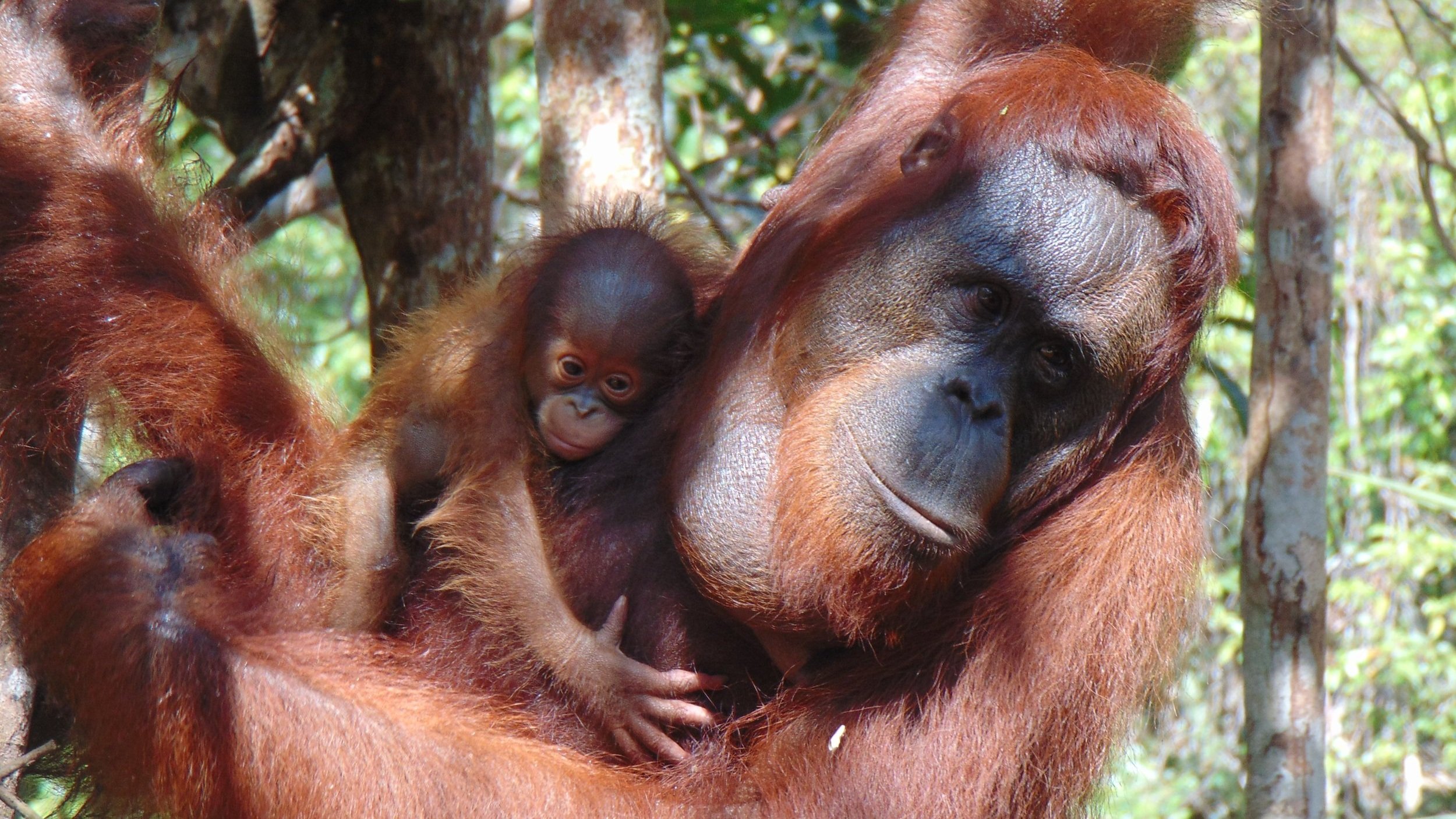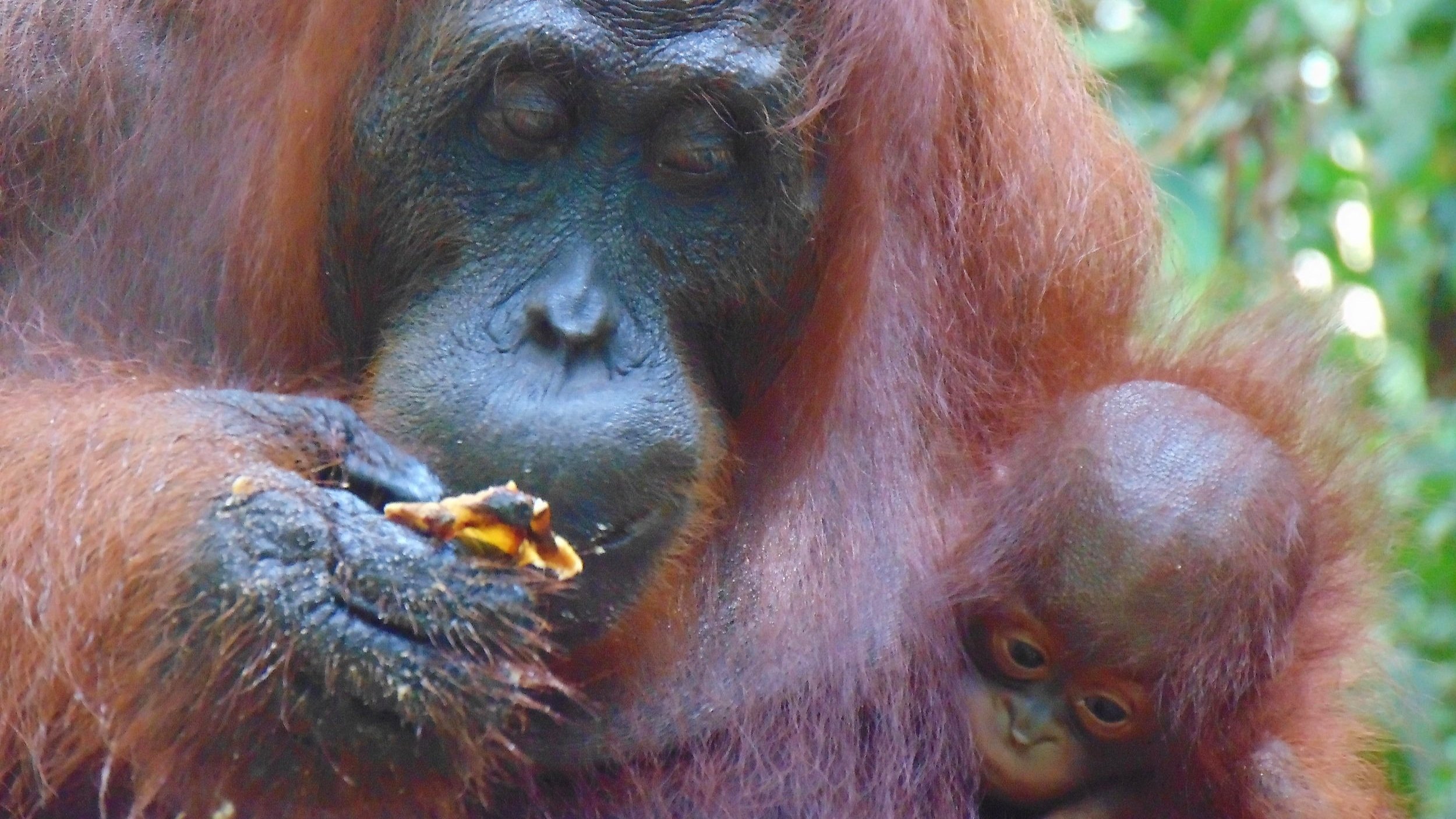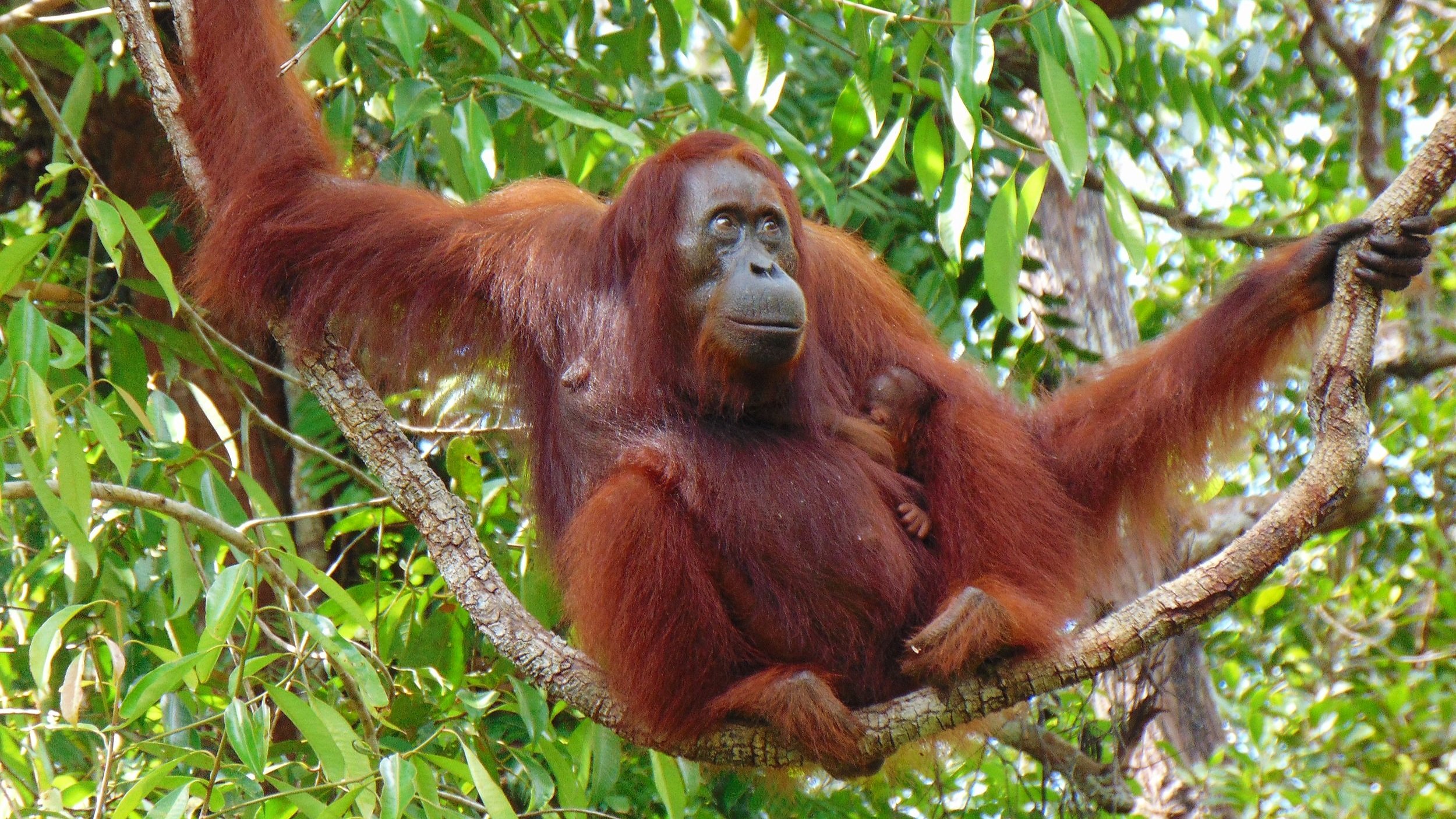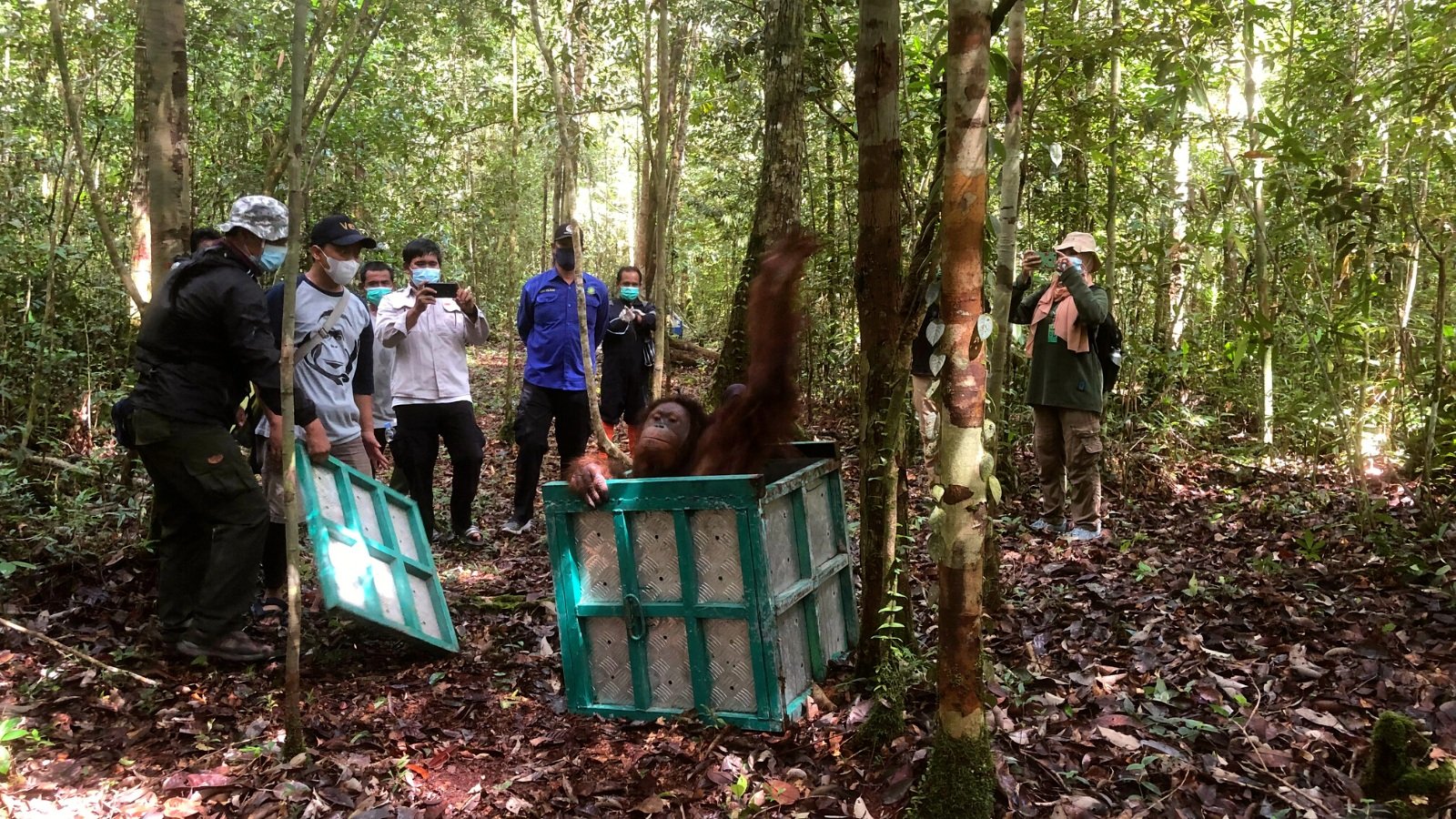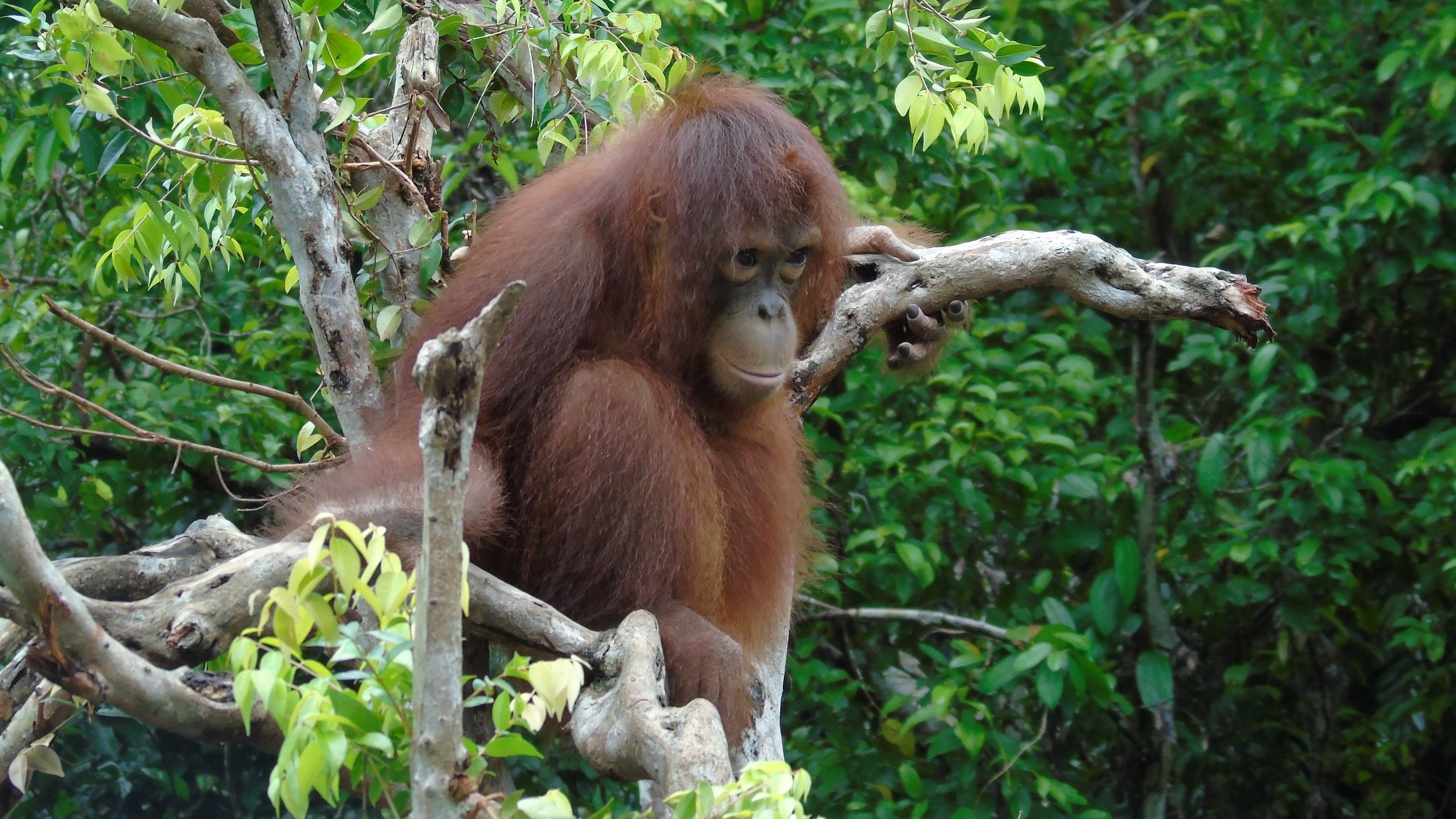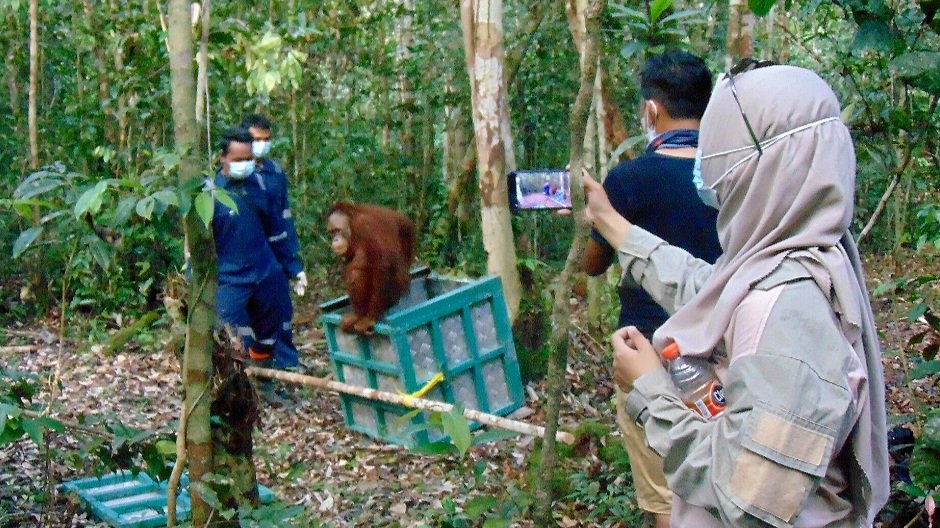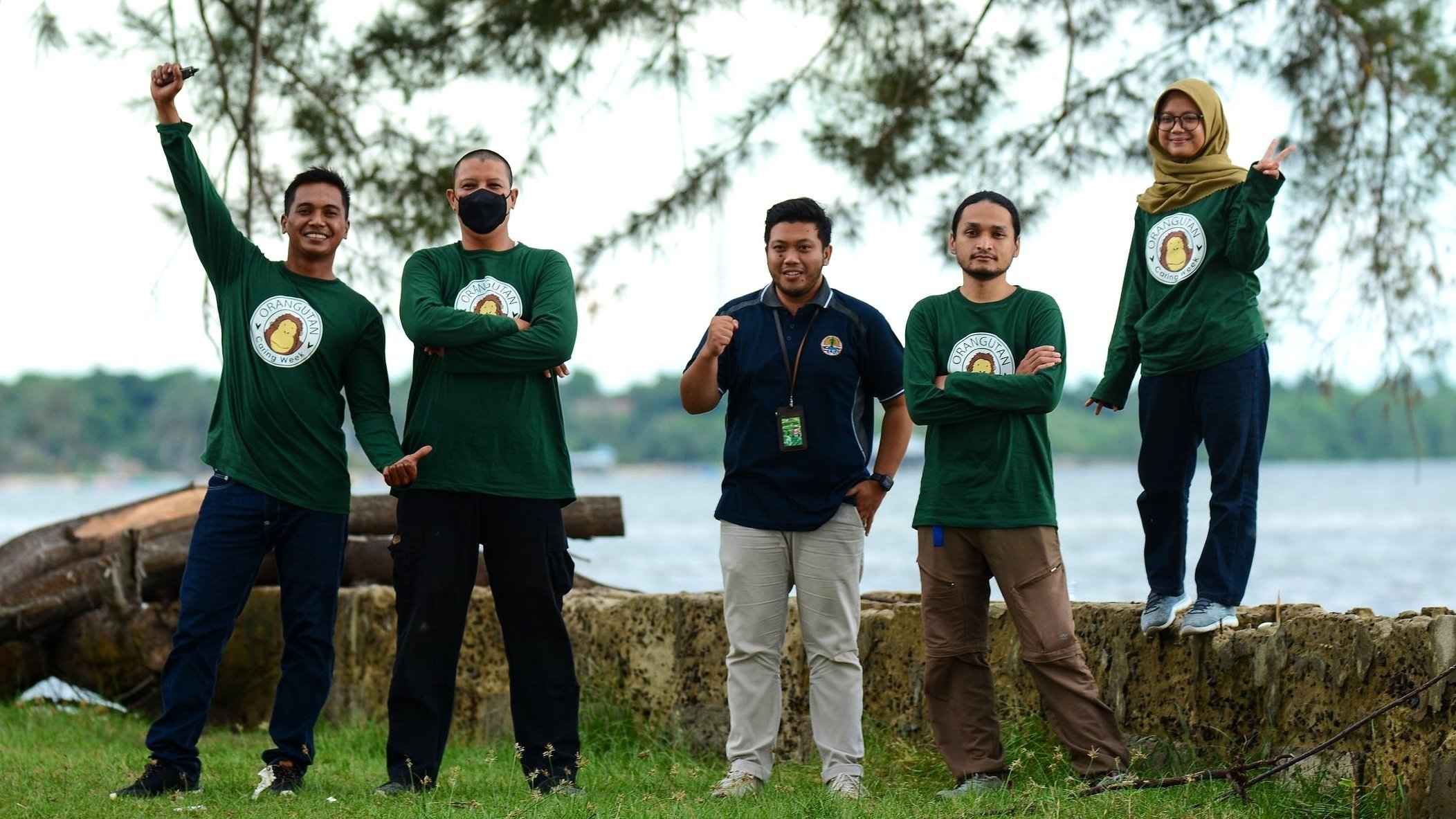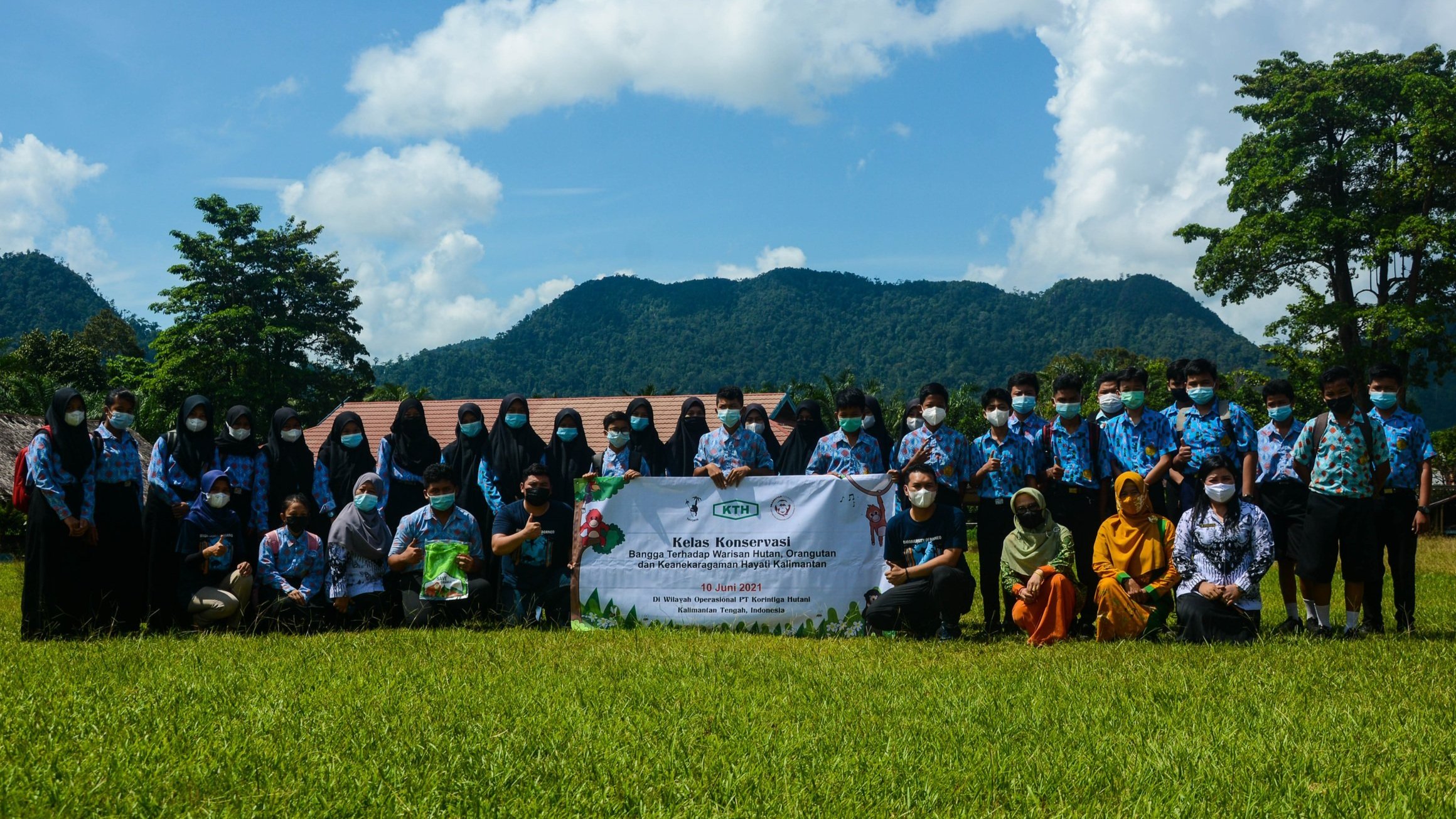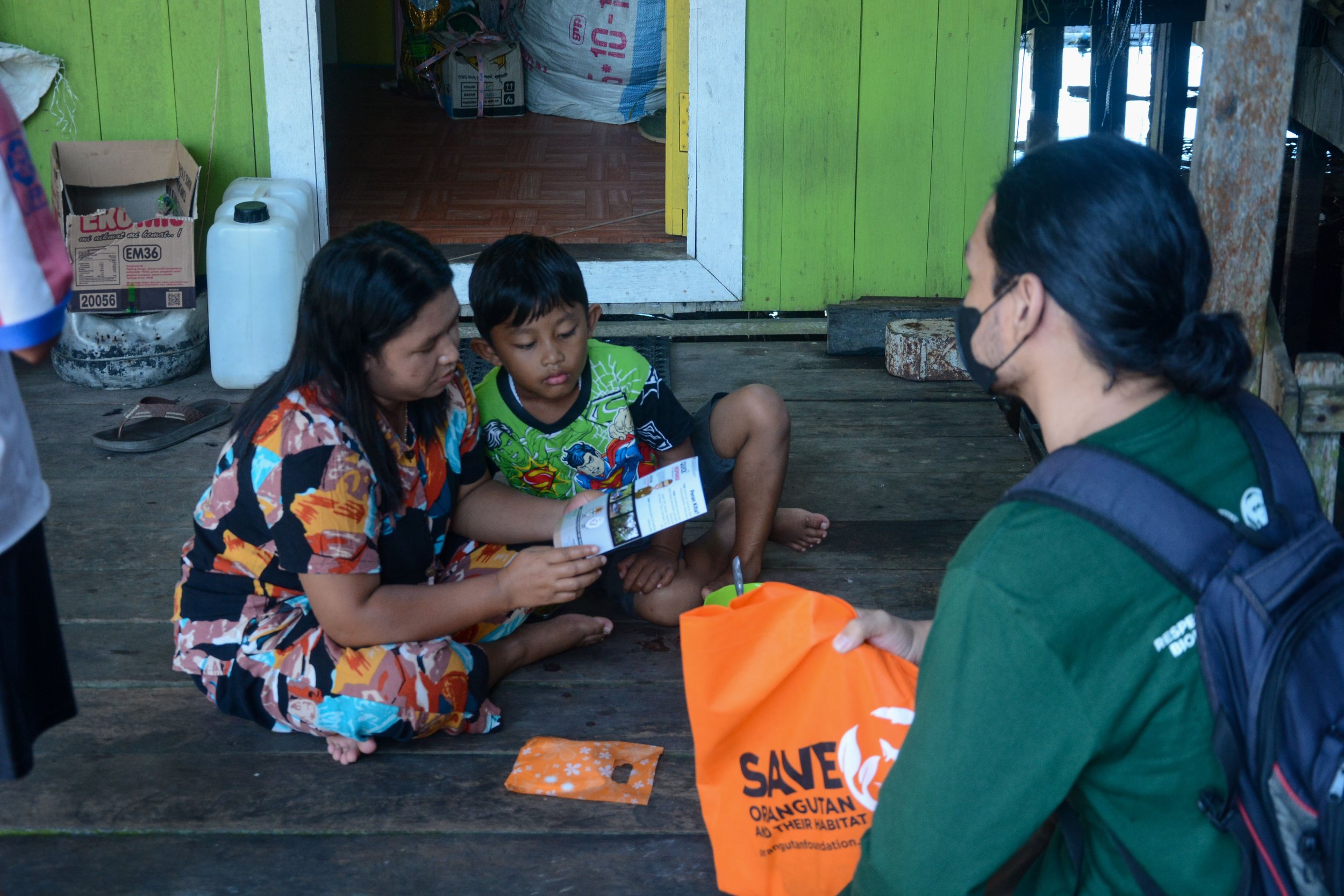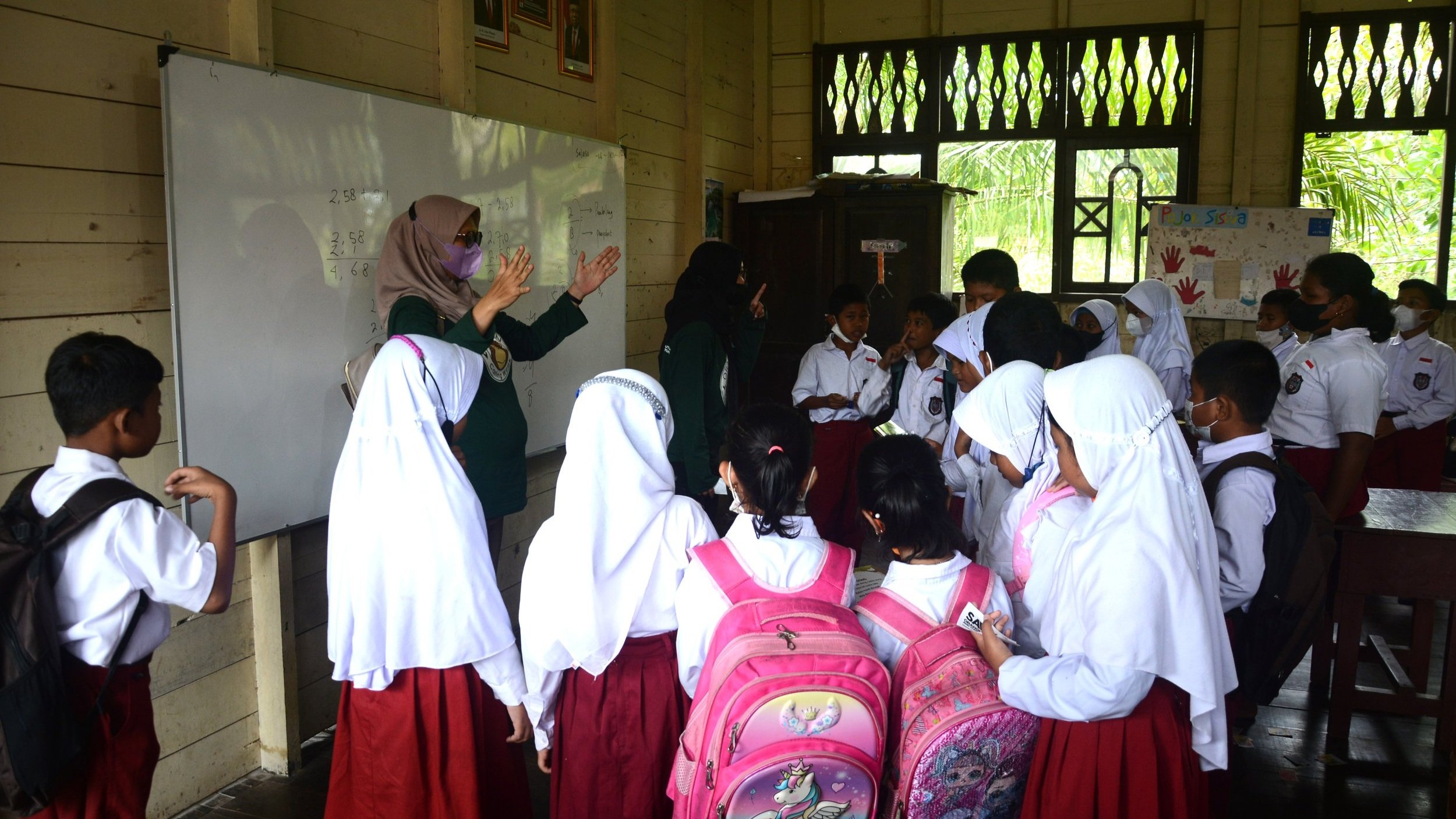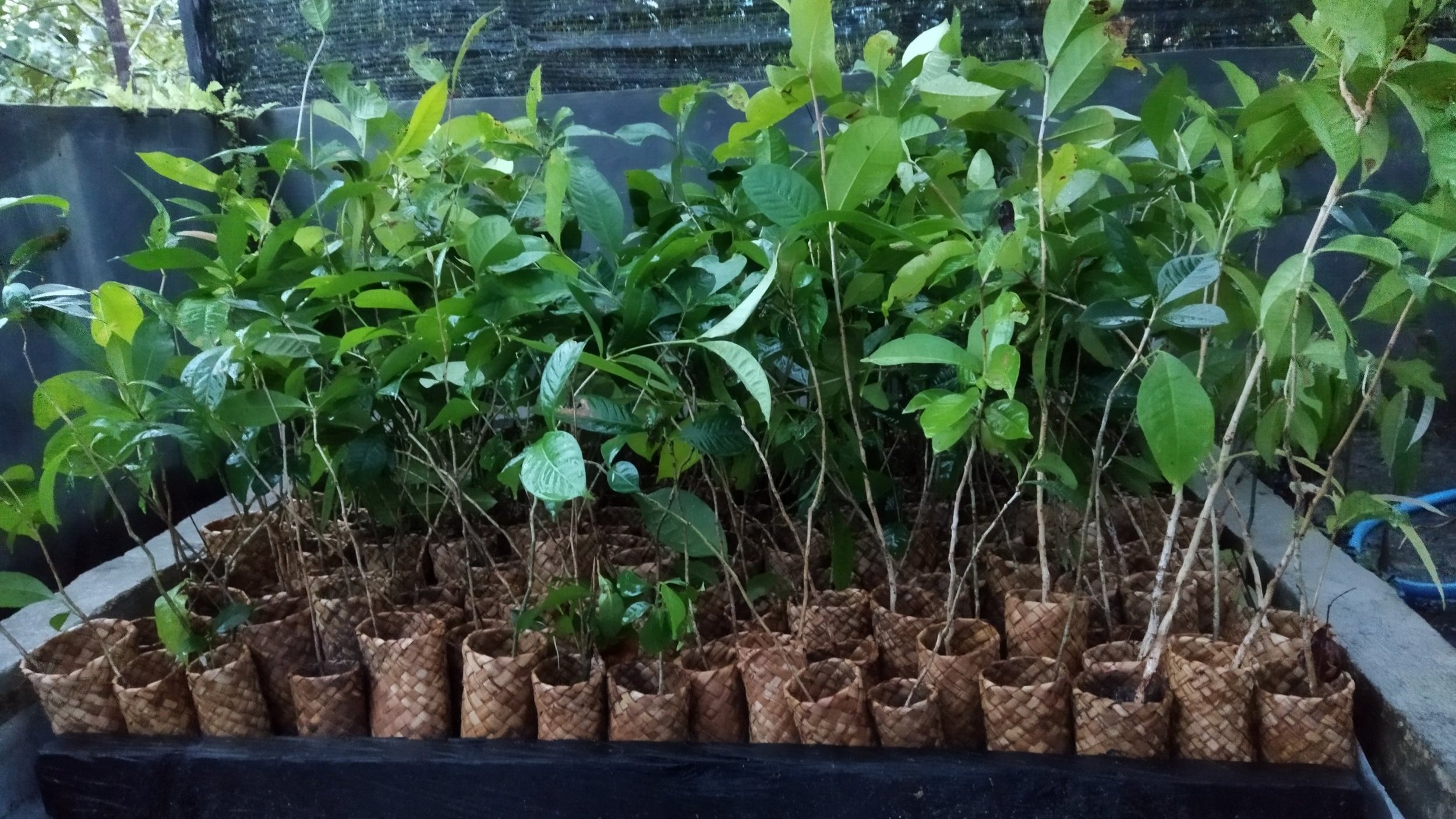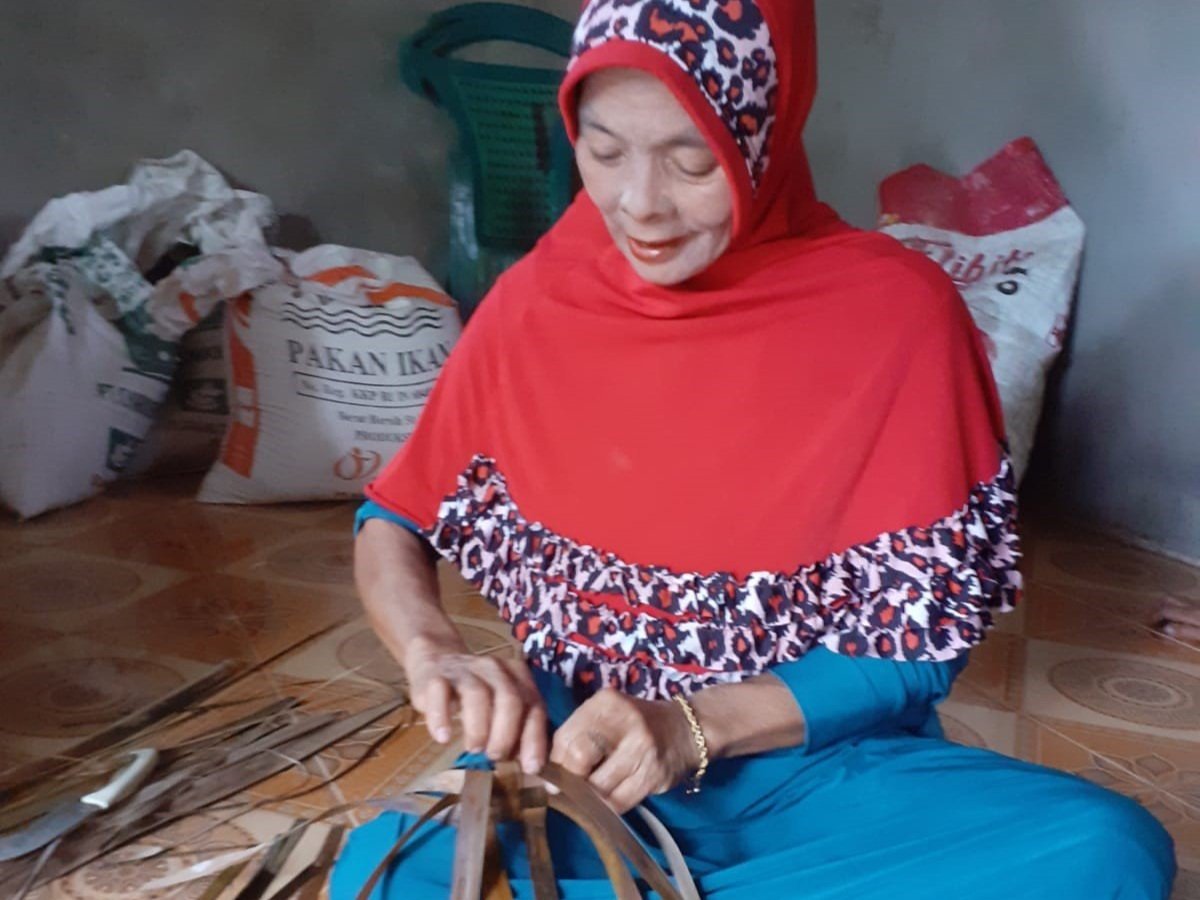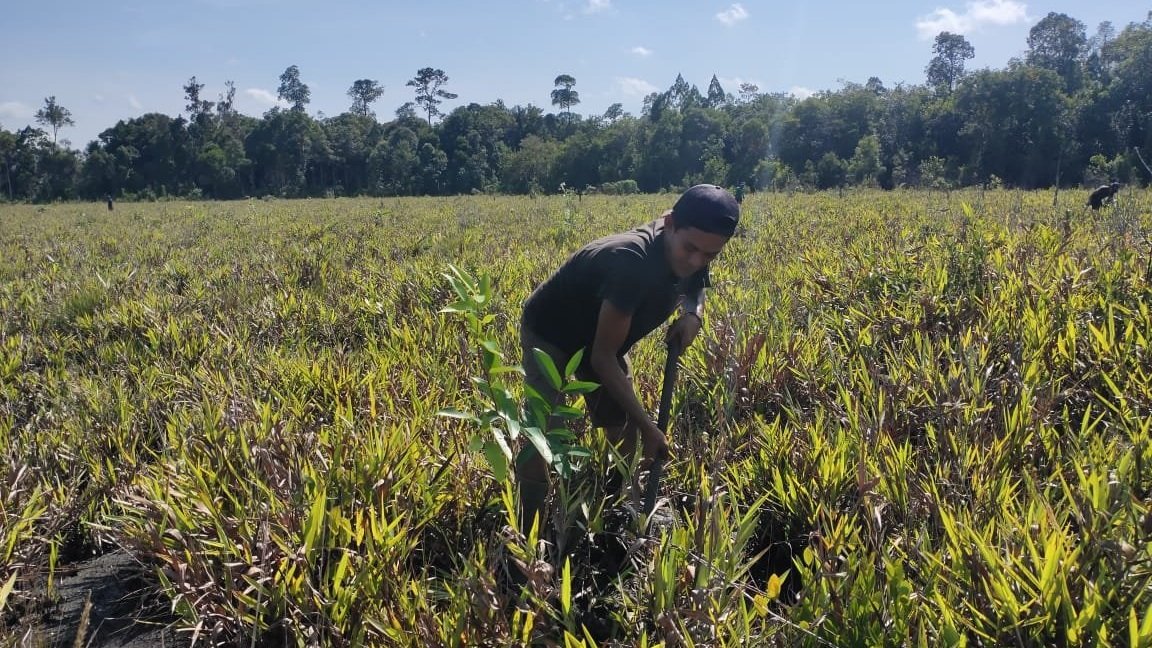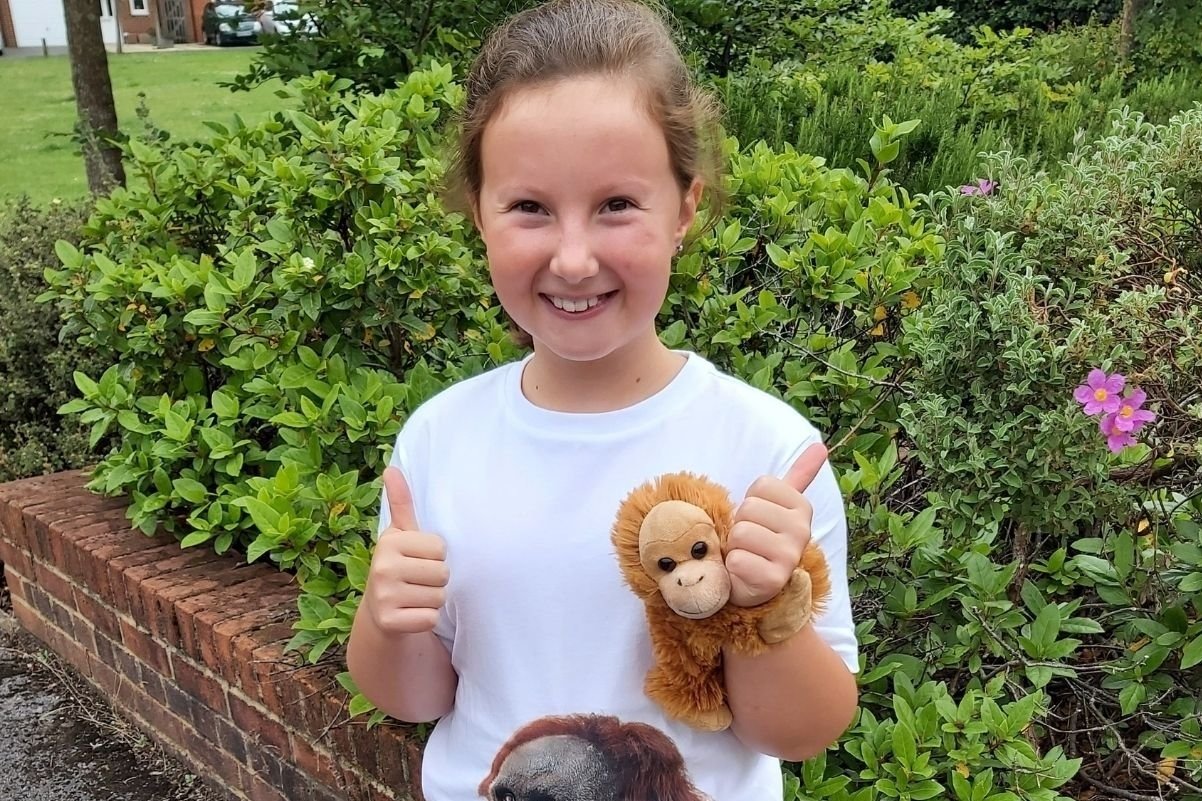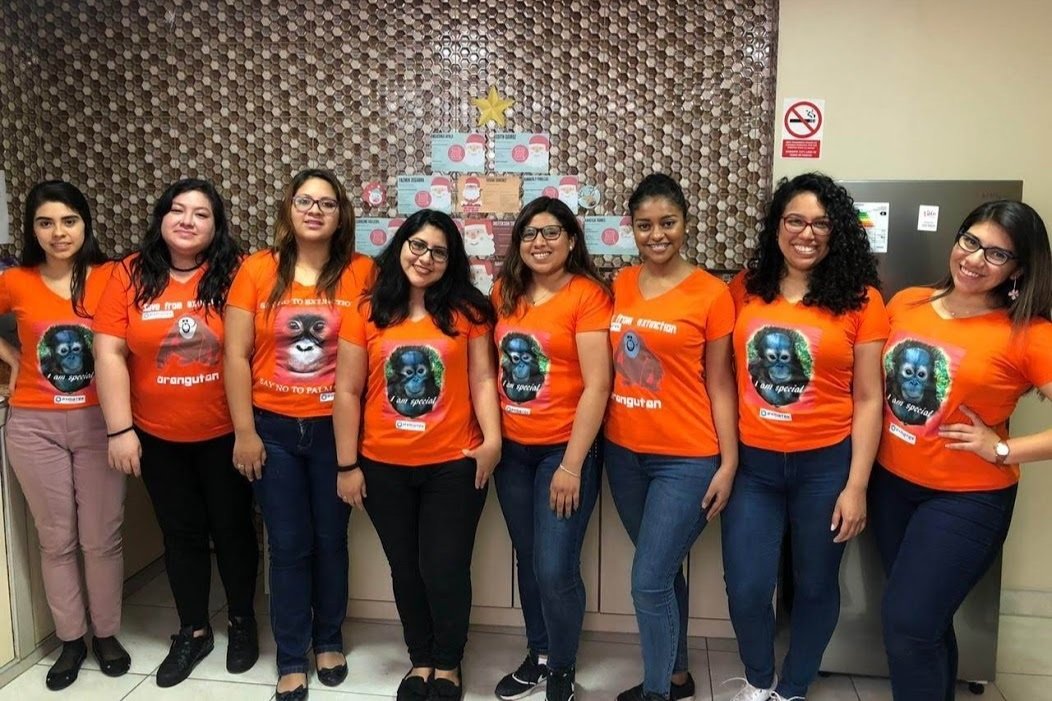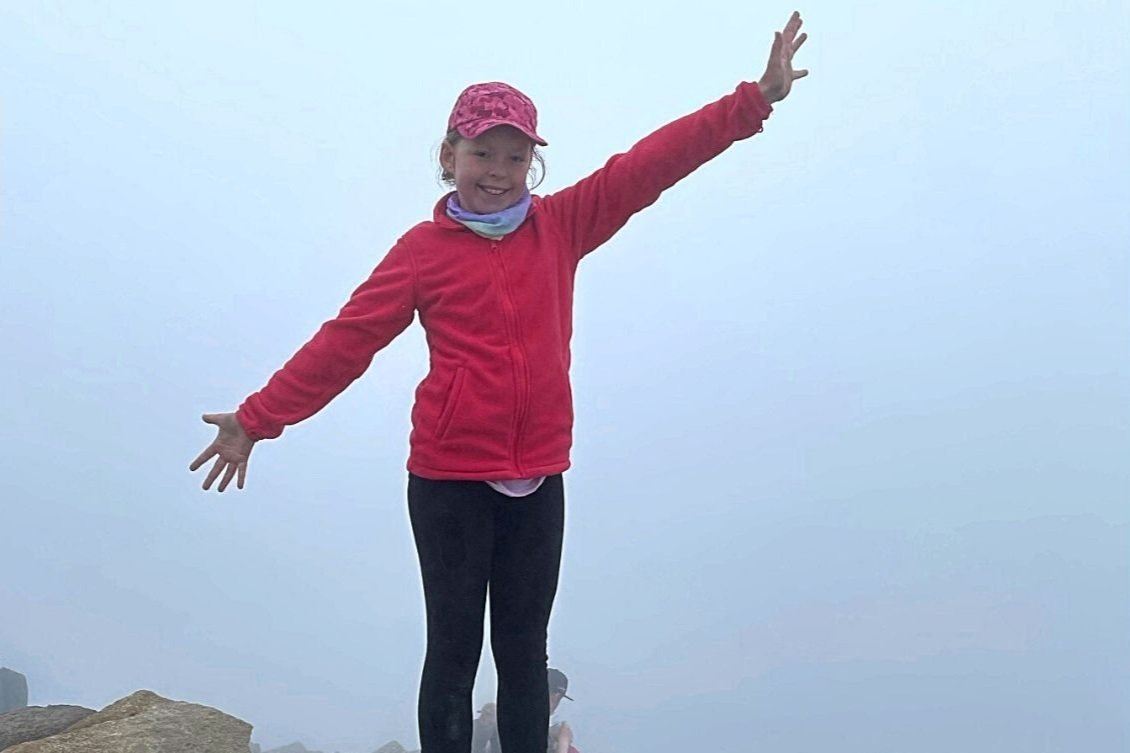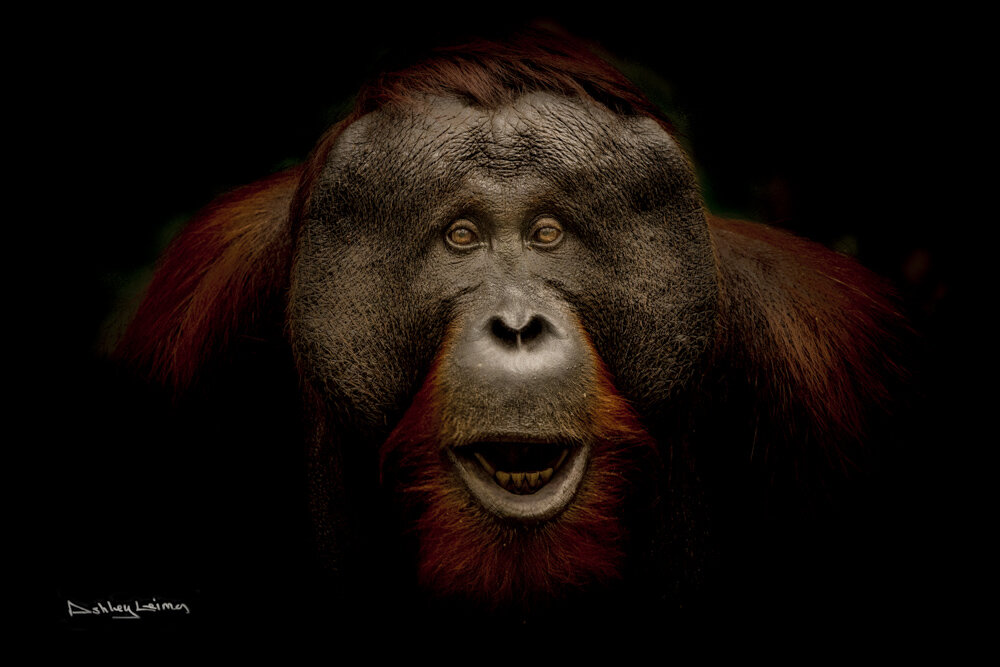Have you ever wondered what it’s like to be an orangutan carer? In the depths of Borneo’s forests, our camps support orphaned orangutans on their journeys back into the wild - and it is the carers that are there for every step of the way. In this ‘In Conversation’, we catch up with the carers of latest release Mona.
Orangutan Stories: Gunawan‘s progress in the soft-release programme!
Orangutan Stories: Epeng - new home, new hope
Orangutan Stories: welcome to Amel – but what happens to the mothers of orphaned orangutans?
Orangutan Stories: Sony lends a helping hand to his sibling!
Orangutan Stories: Death and Birth - The Circle of Life in the Wild
Orangutan Stories: Exploring Food in the Forest
2021 - A year to remember
With your support, 2021 has undoubtedly been a year to remember:
New Life. After nine months of waiting, there’s nothing more exciting for our orangutan monitoring teams than to see a female arriving at camp with an infant; and this happened seven times in Lamandau Wildlife Reserve in 2020!
Remarkably in 2021, we’ve continued to witness even more orangutan births. First came Sheila with her infant Silva, followed by Ilik with her infant Ilan, and recently we’ve spotted Camelia with her infant Tasia! When we consider that our team have documented 92 wild orangutan births in this forest between 2003 and 2021, it shows that this Reserve is clearly an optimum habitat for this species. Knowing we have increased the population of a critically endangered species by 92 has to be one of our proudest achievements.
Second Chances. When restrictions from the pandemic eased, it gave our field team the opportunity to complete the final and perhaps most rewarding part of our orangutan soft-release programme, to release orphans back into the wild where they belong.
Okto, Pegi, and Bumi were each previously kept as pets so they had many skills to learn without their mother. It’s therefore understandable for them to take some time to become fully prepared for an independent life. Together this trio had spent almost a decade under the tutelage of our staff, until this year the time had finally come for them to be released and explore the forest on their own.
Following these departures, this year we also welcomed a new face into our care when one-year-old Sinta was discovered alone and abandoned in the Reserve. In soft-release she will have the opportunity to strengthen her forest skills so that she too can be released one day!
A Flourishing Forest. We know that tropical rainforests are the most biodiverse terrestrial ecosystems on earth, but there’s so much of this rich habitat we cannot see. By strategically positioning remote camera traps and carrying out surveys in the dead of night, we can glimpse a little more into this hidden world.
This year our team at Pondok Ambung Tropical Forest Research Station have continued to monitor the health of Tanjung Puting National Park’s biodiversity by recording sightings of vulnerable species such as tarsiers, clouded leopards, sun bears, proboscis monkeys, false gharial crocodiles, and many more. If we needed reminders to why we should protect this forest, what better examples than these!
Working Remotely. You don’t get the best Wi-Fi signal in the rainforest, but technology has enabled us to communicate and engage with wider audiences from homes and offices this year. On International Day of Forests in March, our Director Ashley Leiman OBE together with Ian Redmond OBE and Dr Ian Singleton OBE hosted an enlightening live webinar to discuss the past, present, and future of orangutan conservation.
In the field our team have also embraced this new way of working. Conservation Corner for example is a section our local office where youth groups, students, researchers, and members of the conservation community would meet to exchange strategies and ideas. Now this discussion is often held online which means that it can be shared quickly and be accessible to a wider audience.
Cooperation. In June we were delighted to sign our third Memorandum of Understanding with the Indonesian Ministry of Environment & Forestry allowing Orangutan Foundation to continue our work in Central Kalimantan.
Following the tightest restrictions of the pandemic, our engagement team couldn’t wait to get back out to schools and local communities this year. Several educational events were hosted in 2021, including some wonderful activities for Orangutan Caring Week in November. Our dedicated team visited nearby villages and schools to raise awareness by handing out leaflets, books, and T-shirts. They were thrilled to see such enthusiasm on the faces of younger generations, and it was eye-opening to understand more about how animals from the forest and rivers impact the daily lives of local people. This cooperation and knowledge is essential to continue our vital work.
Future Forests. Forest fires occur each year in South East Asia. Fortunately though in 2021, we were pleased to see that the habitats we protect were not severely affected by fires, instead it was flooding that impacted many of our forest guard posts. This too is a reminder that the impacts of global warming are undeniably being felt in this part of the world.
Following the COP26 summit, our Forest Restoration team cultivated and planted around 30,000 young tree saplings this year to help reduce the impacts of climate change. Additionally, they decided to reduce our plastic waste by making the switch to biodegradable sapling bags. These bags are hand-made from pandan leaves by local villagers, providing an additional source of income and encouraging nearby communities to support their natural world.
Your Support. 2021 has been unique in many ways, but as in previous years, we have still received unwavering support from members, followers, and fundraisers this year.
Your commitment helped us reach our fundraising targets for our Green Match Fund, Christmas Challenge, and for International Orangutan Day you protected over 2,500 acres of orangutan habitat! Not to mention the sponsored bike rides, fun run’s, and bake sales which have all made a massive contribution towards the protection of critically endangered orangutans and the safeguarding of their crucial forest environment.
Thank you to everyone who has supported our ongoing conservation programmes this year and with your help we look forward to another memorable year in 2022!
Even 2020 can be an Inspiration
We didn’t expect our recap of 2020 to be quite like this.
Last year we were looking forward to celebrating the Foundation’s 30th anniversary, however life had other plans for all of us. COVID-19 impacted the lives of everyone both in the UK and in Indonesia, which meant we had to adapt. To commemorate our anniversary, we published a booklet ‘Orangutan Foundation - 30 Years of Conservation’.
Orangutans share around 97% of their DNA with humans, which means COVID-19 poses a potential threat to this critically endangered species. Fortunately however, none of the orangutans we monitor, or any of our 60 local staff have been taken ill by the virus. In fact if a small silver lining can be drawn from this difficult situation, it is that working and communicating remotely where possible has meant that everyone has learnt how to embrace the use of new technology, Zoom!
Community outreach and education is one of the fundamental cornerstones of the Foundation’s work. Therefore during lockdown, our team had to find new ways of working together remotely.
Conservation Corner, before and during the pandemic. This is a platform where local youth groups, students, researchers, and members of the conservation community can meet to exchange concepts and ideas. One online session had close to 100 people joining in, demonstrating the concern that younger members of the community have for the environment.
Local events are vital to keep raising awareness and promote habitat protection, and luckily before restrictions last year, we were able to hold a number of community activities. Including:
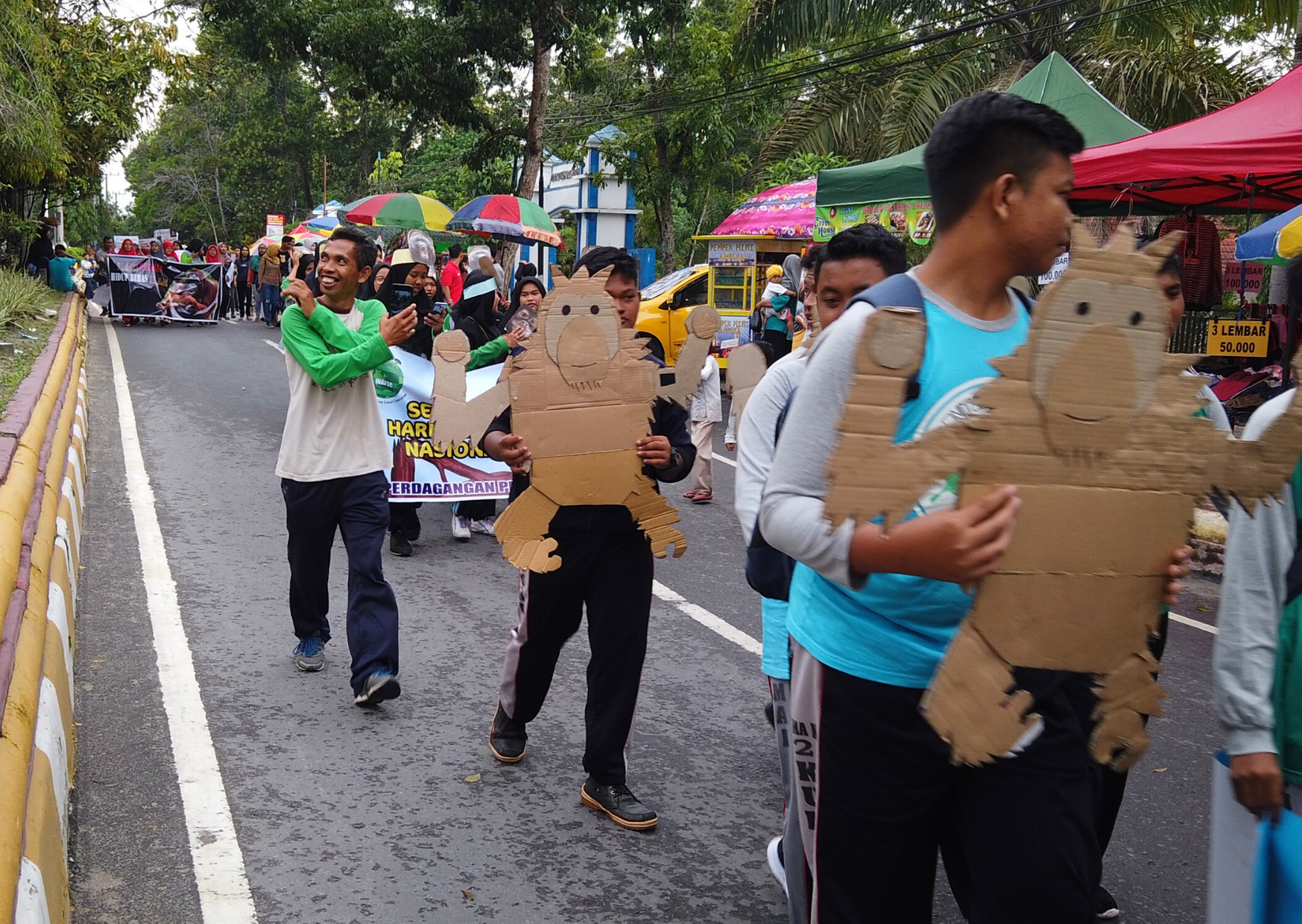
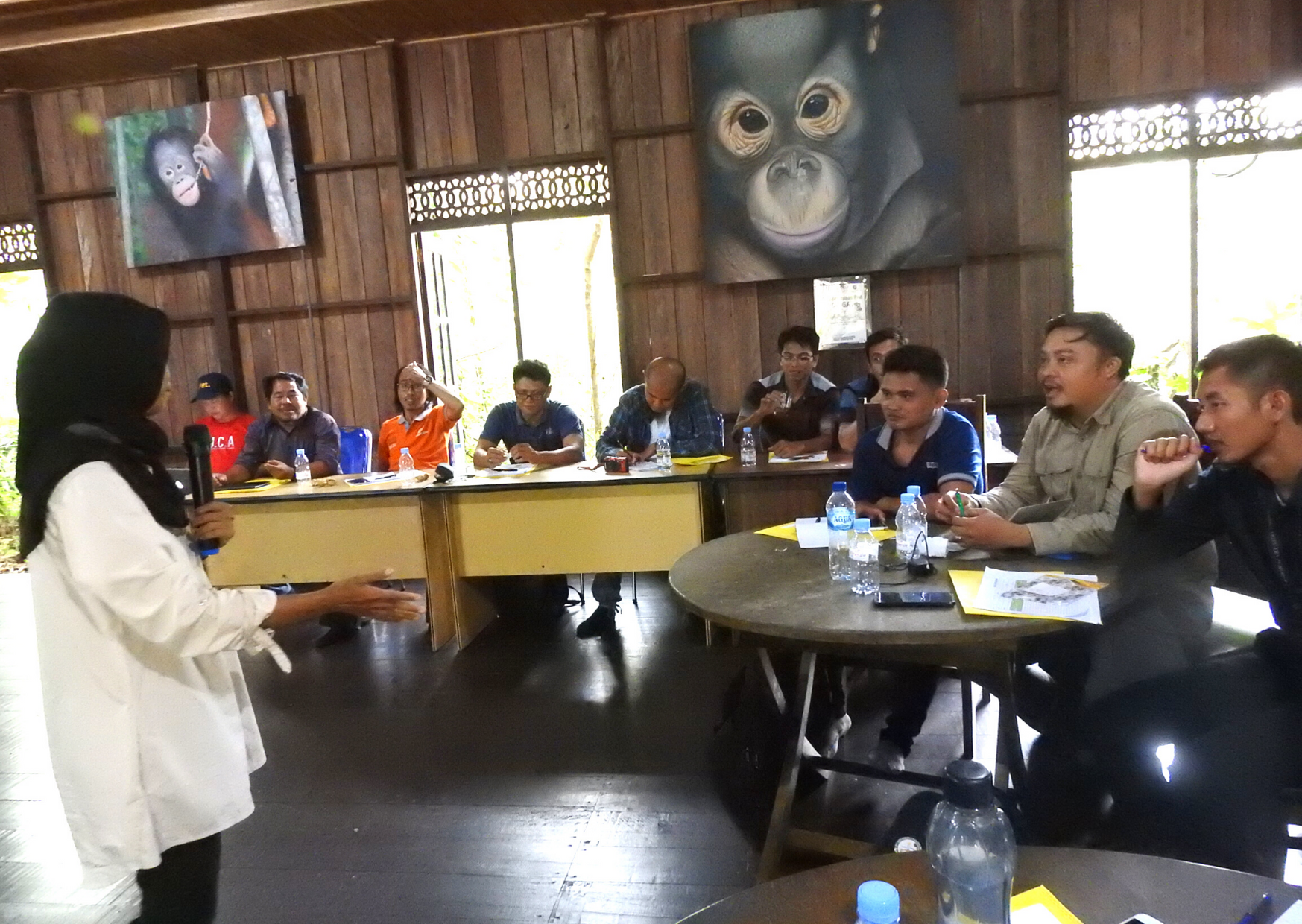


Our Forest Restoration Programme was active throughout the year. Our team planted an additional 16,500 young trees in areas which one day will bolster existing forest boundaries.
Much like us, in 2020 the forest also faced a new challenge. The rainforests of Central Kalimantan in Indonesian Borneo suffered some of the most severe flooding in recent memory, submerging large areas of habitat for much of the year. This is a stark contrast to previous years which would have been battling forest fires during the dry season. A striking reminder of how unpredictable our weather patterns have become as the impacts of climate change take hold.
Unsurprisingly, it was the orangutans that gave us the best news and most amusing stories last year. The orphaned orangutans in our soft-release programme for example continued to go from strength to strength as they develop new forest skills, with Okto in particular, impatient for an independent life in the wild.
In June, we were very excited to discover that wild orangutan Pauline had given birth in the Lamandau Wildlife Reserve. Then shortly after, our field team were surprised again when Queen showed off her infant. Two recorded births of these great apes in such a short space of time is unusual, so to have observed a remarkable seven orangutan arrivals by the end of November was truly astonishing! It’s an extremely rare occurrence to have so many recorded births in less than 6 months, but a welcome boost for the future of this critically endangered species.

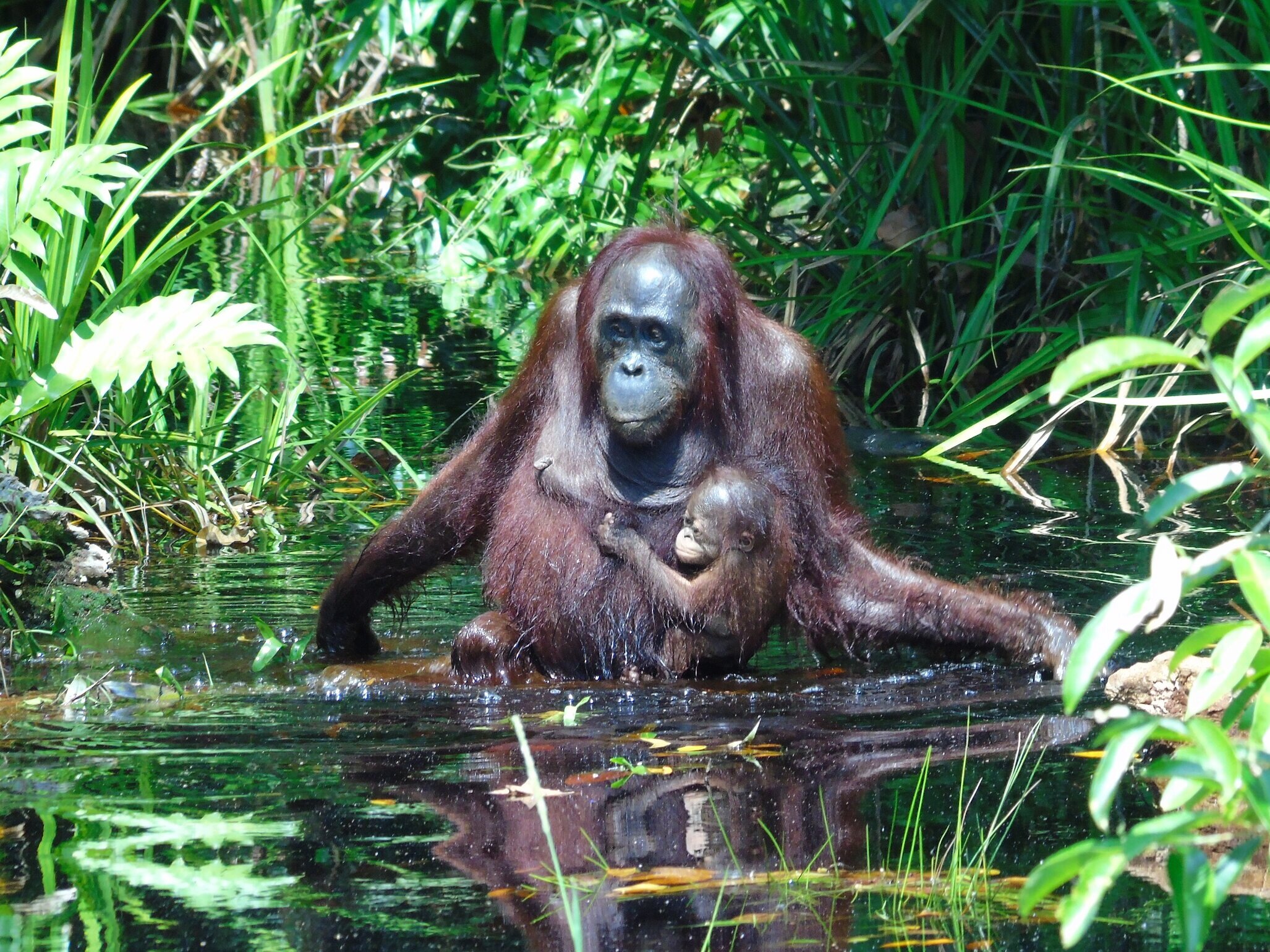
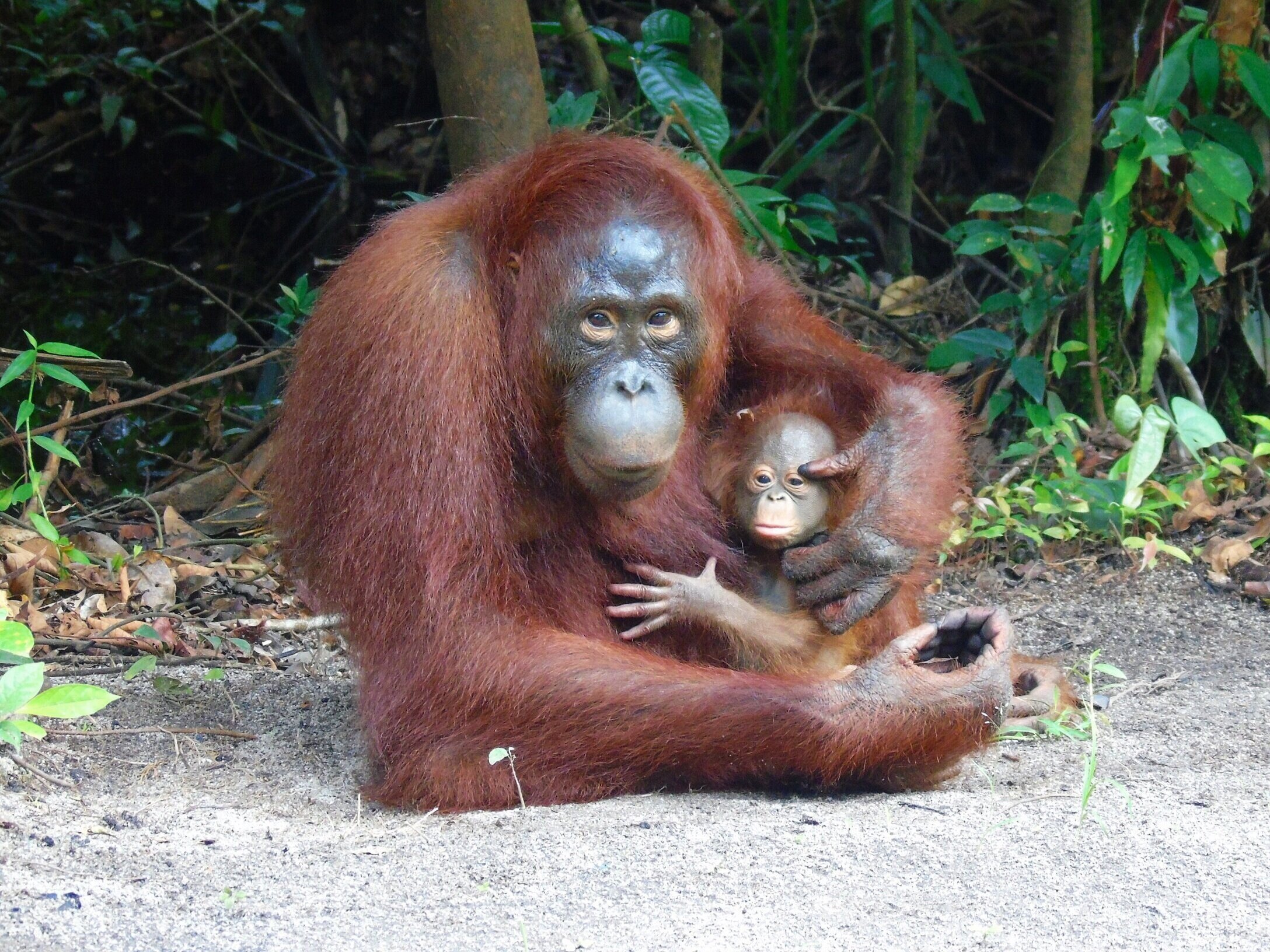
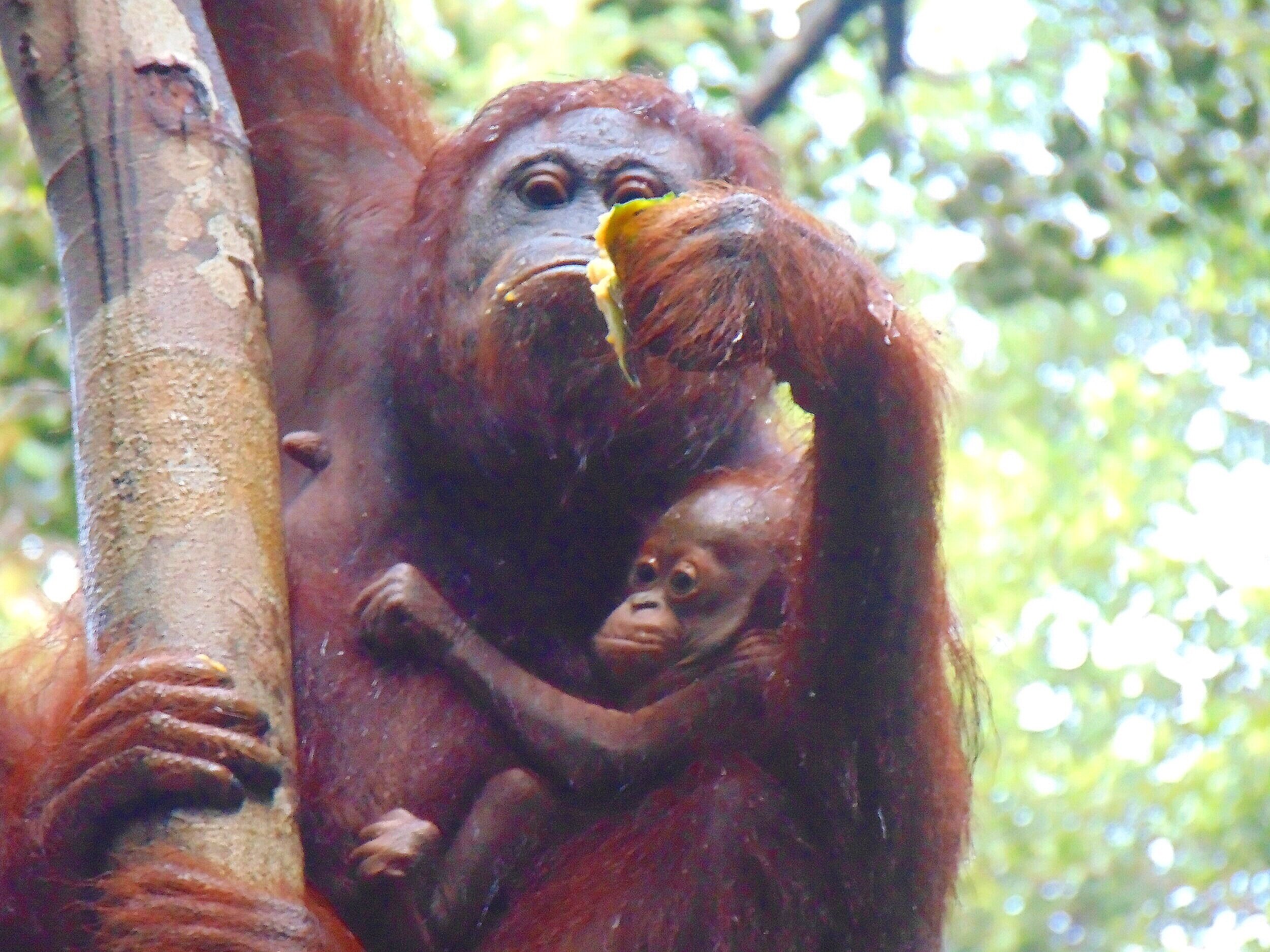
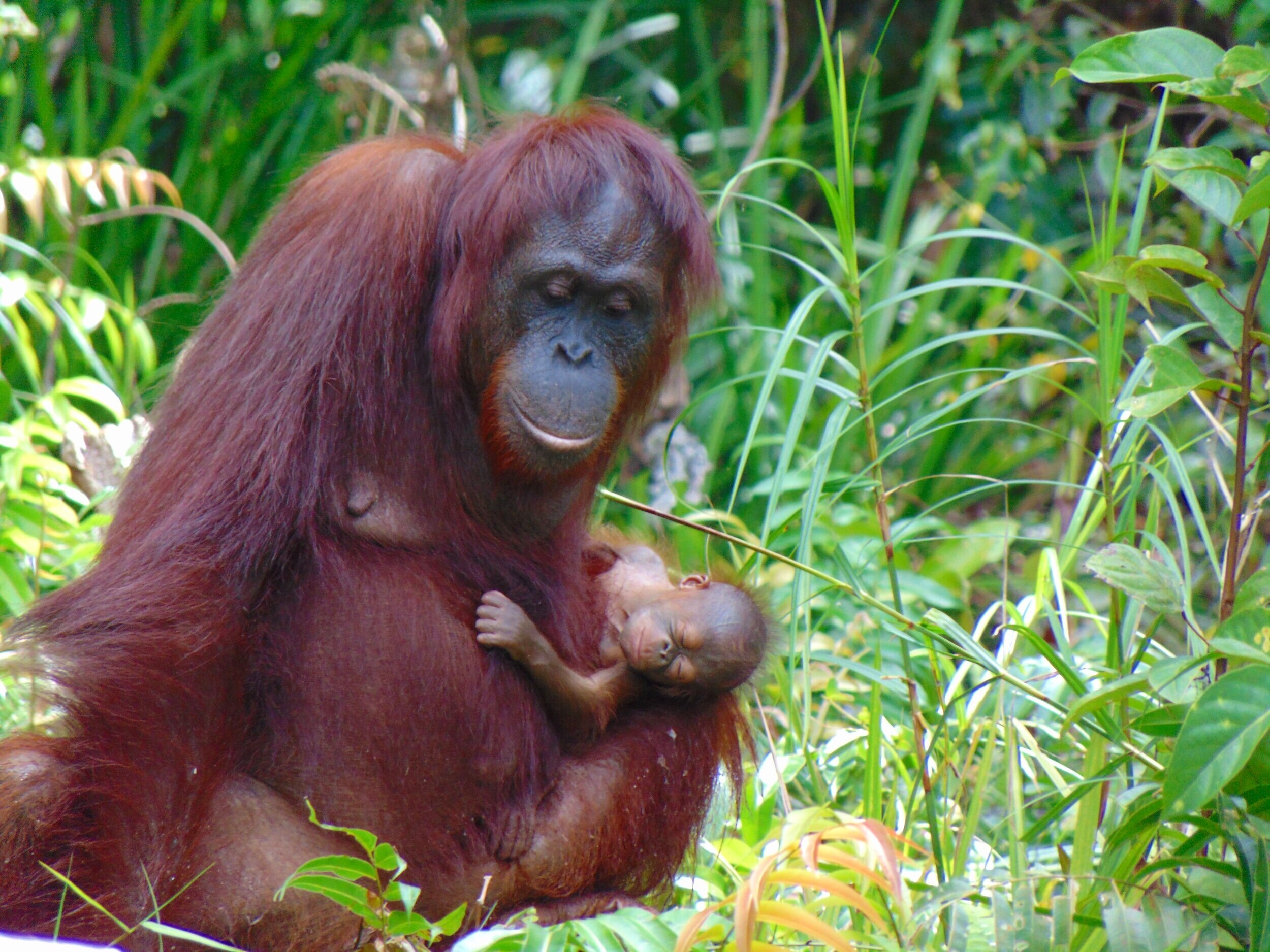

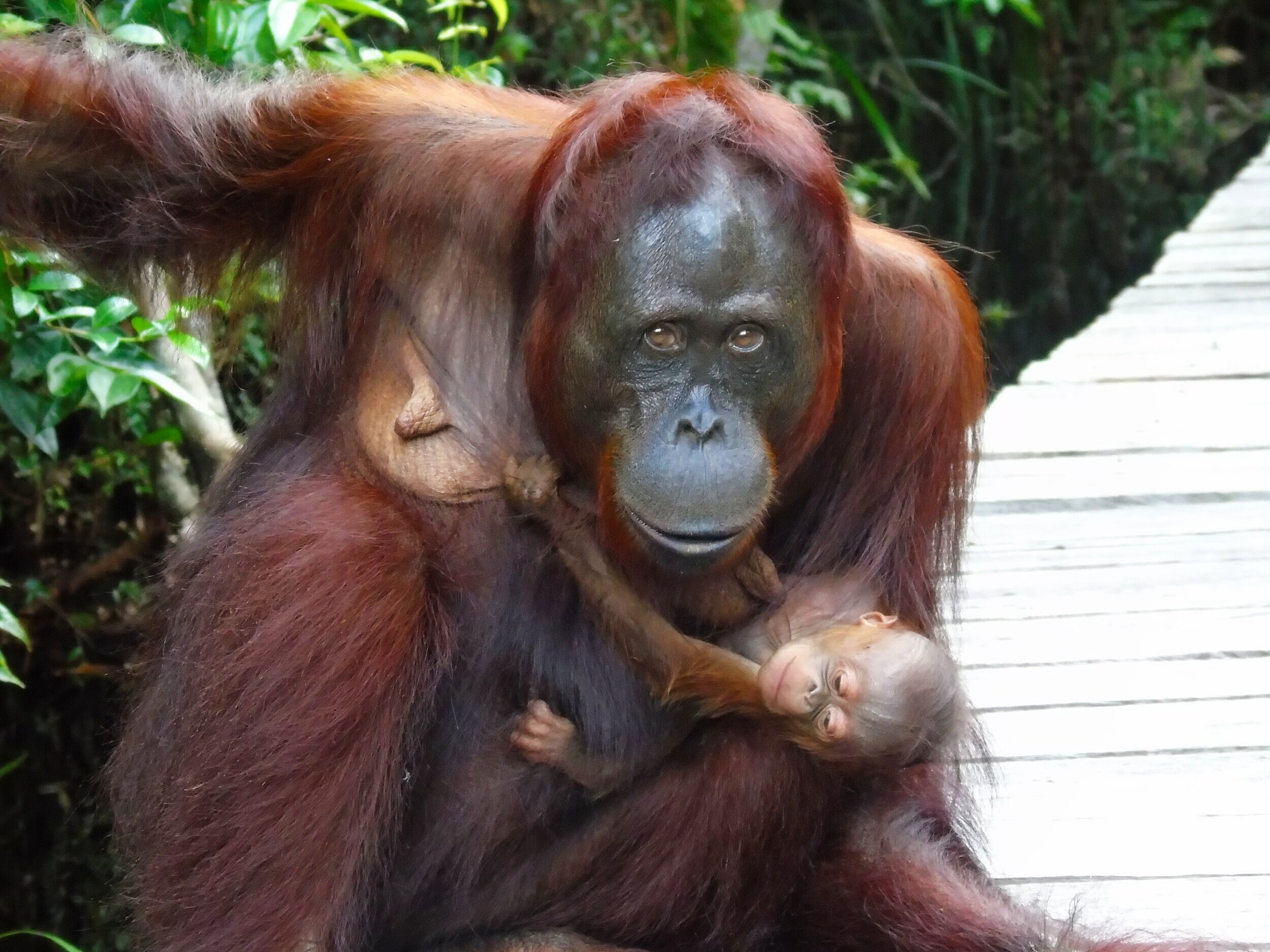
We were truly blown away by your support in 2020, in spite of restrictions. In particular for our 30th Anniversary Appeal which launched last year in collaboration with SOCP (The Sumatran Orangutan Conservation Programme), helping save all three species of orangutan.
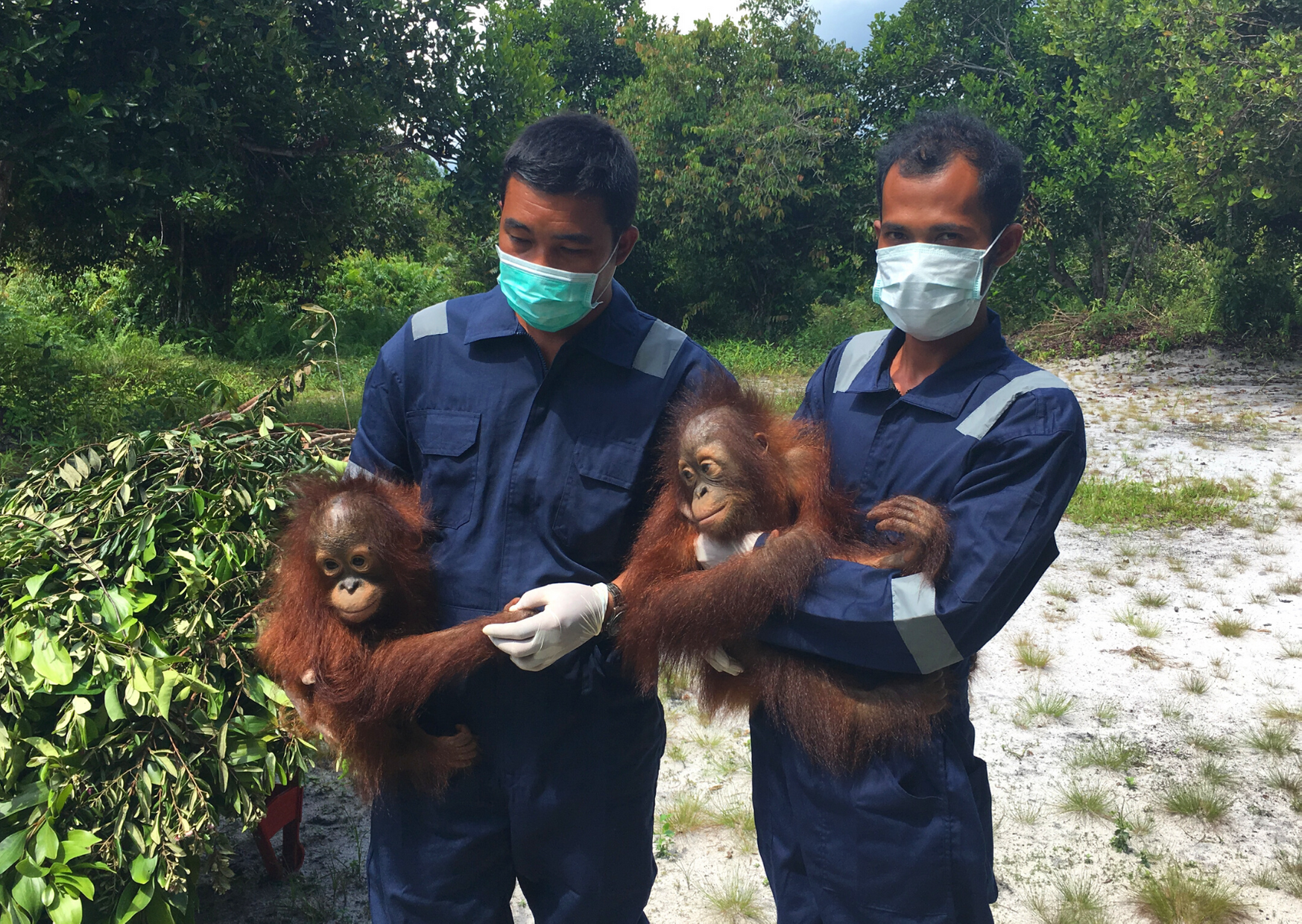
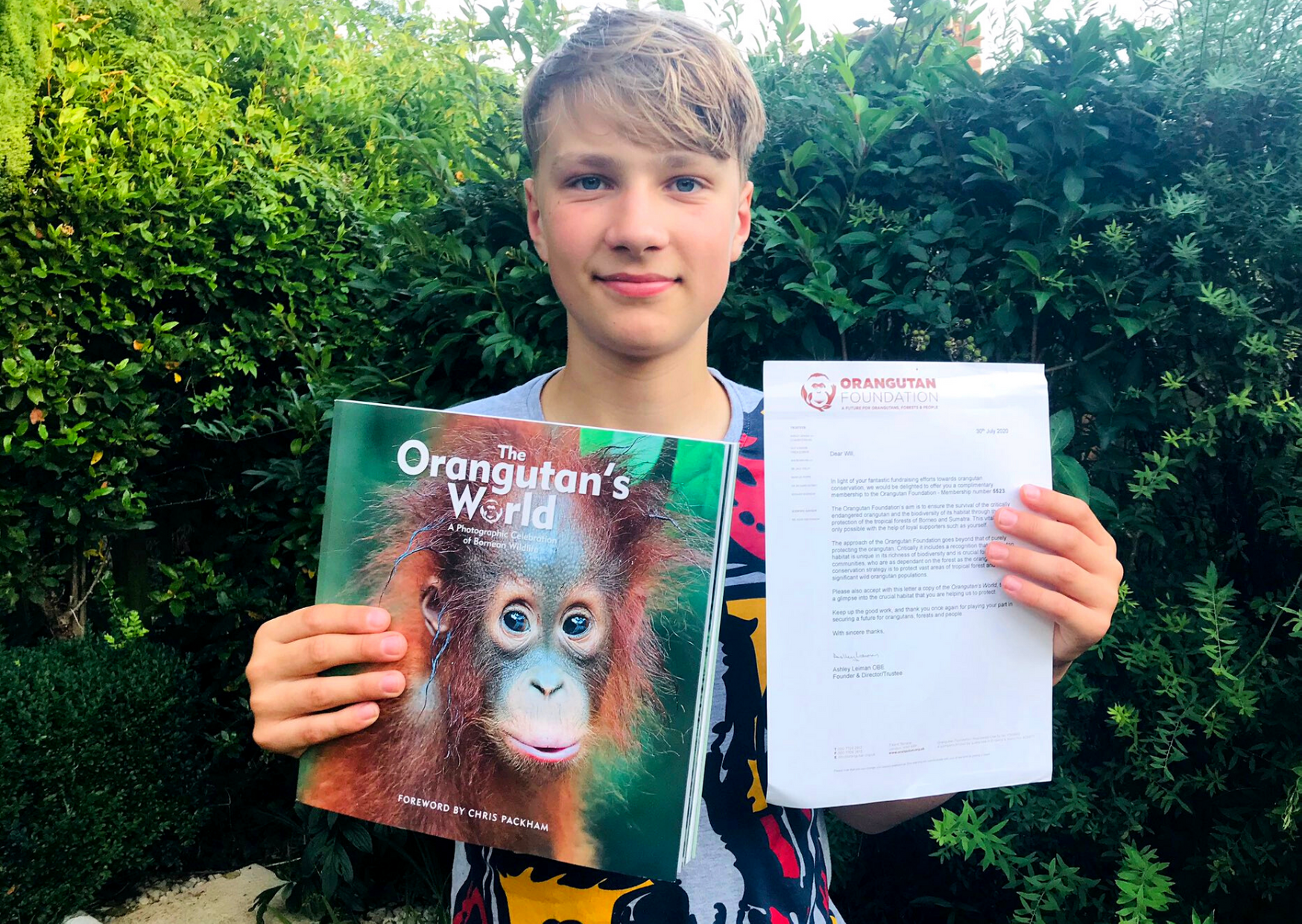
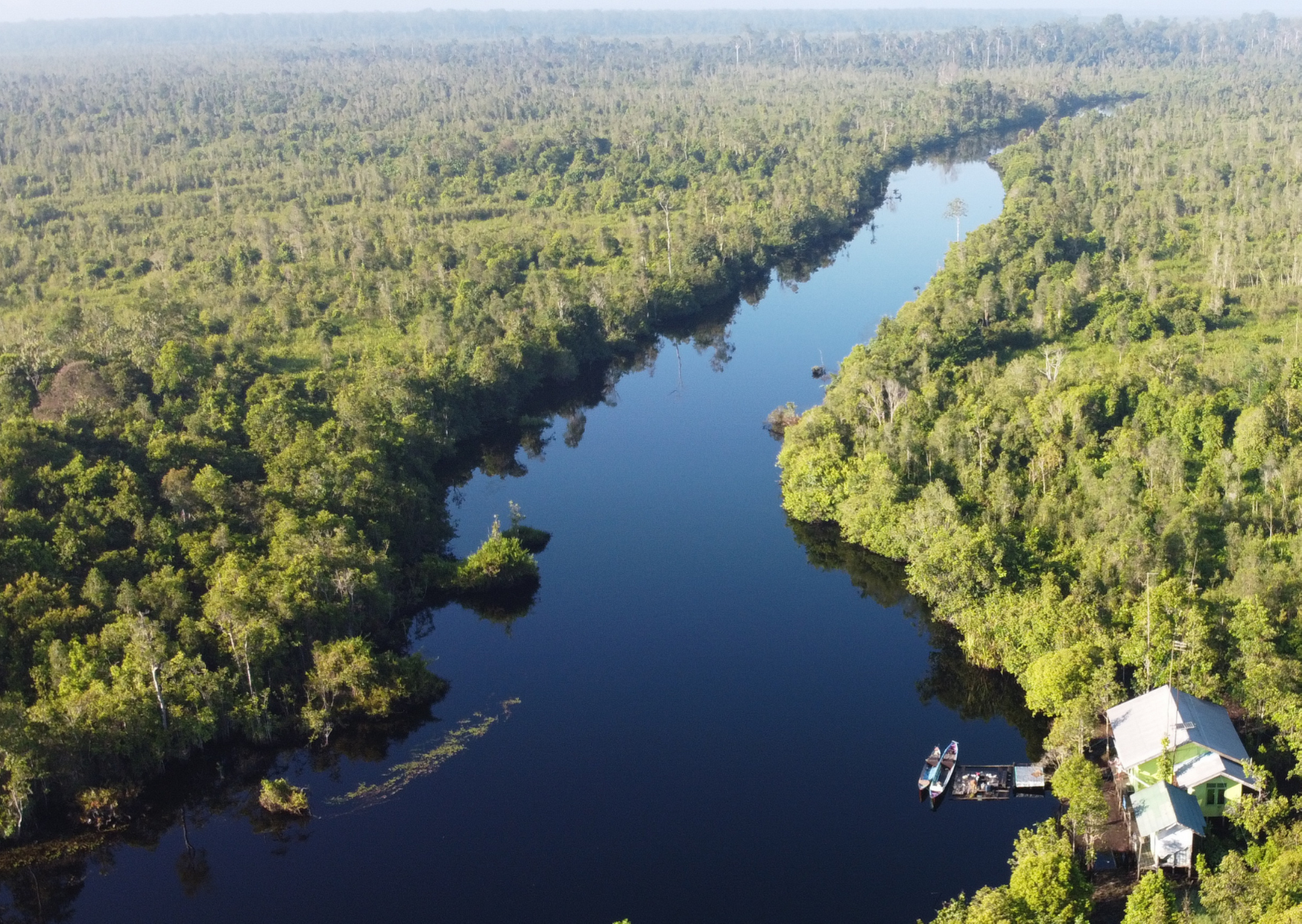

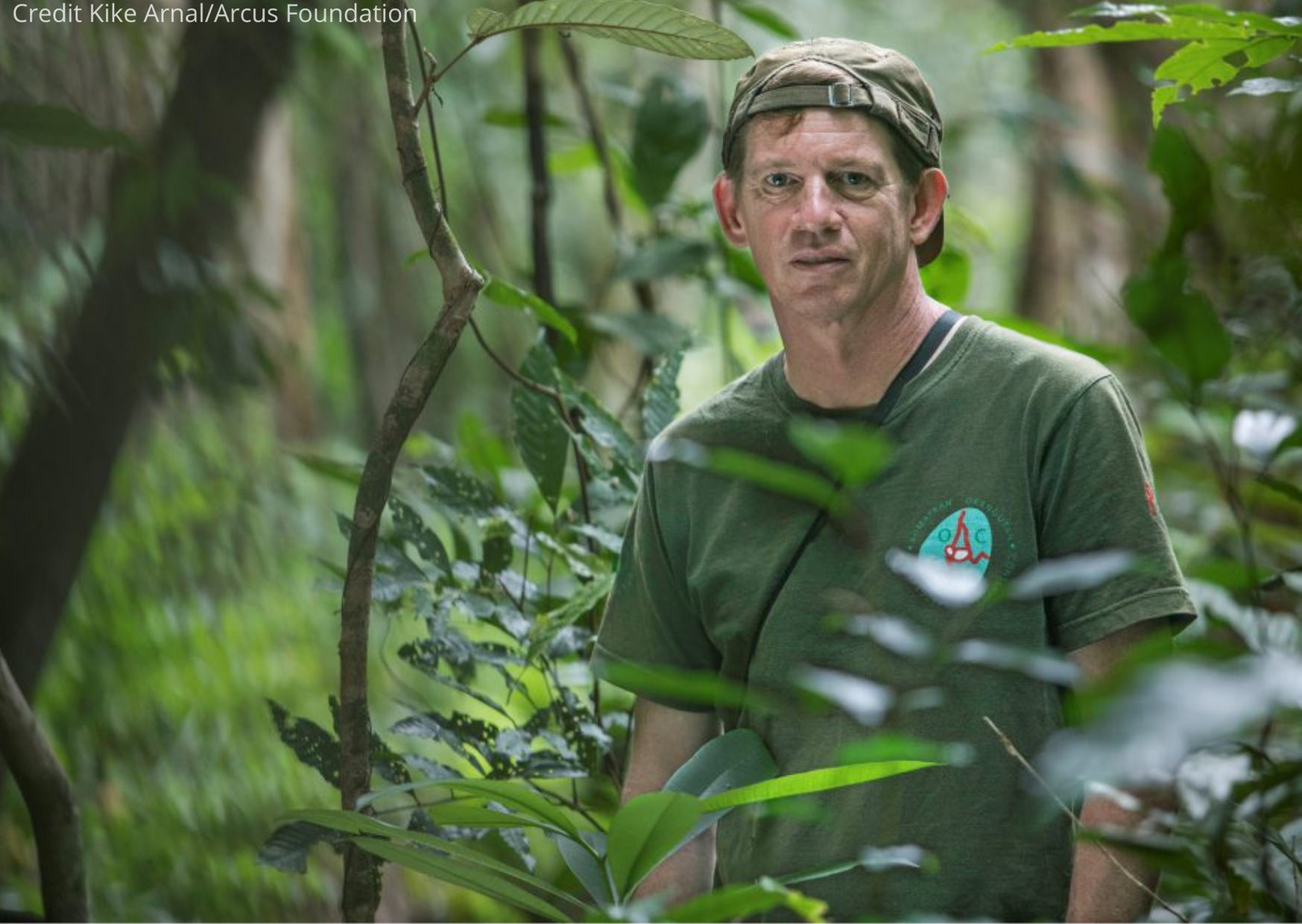
2020 will be remembered for many reasons, but perhaps more than any other year, it must be remembered for the connection we have made between the welfare of our planet and the importance of nature. By continuing to save our forests, we can mitigate the impacts of climate change.
We have been inspired and overwhelmed by the generosity we received in 2020, even through these difficult times. We sincerely appreciate the devotion of all partners, fundraisers, and supporters on Orangutan Foundation’s 30th anniversary year, and look forward to keep making a difference in the years to come.
Great apes in print
We have been working with outstanding wildlife photographer Ian Wood to raise awareness of orangutans and showcase some of Ian's wonderful photographic prints.
For the unique opportunity to obtain a limited edition, high-quality orangutan print, join the online auction here for your chance to bid on a one-off print signed by our Founder & Director/Trustee, Ashley Leiman OBE. You can also visit the Lucy Bell Gallery in St Leonard’s-on Sea before the 14th November to see this amazing work in person!
Additionally, there are five incredible prints available online with 25% of all proceeds going to the Orangutan Foundation. Each print has their own story from Ian:
Photo 1 - Wise man of the forest
A close encounter with this wild male Borneo orangutan in Lamandau wildlife reserve, Kalimantan, Indonesia. This area of forest offers real hope for the future and is where the Orangutan Foundation’s forest regeneration program takes place with tens of 1000s of new trees planted.
Photo 2 - The kiss
Orangutans are the best mothers in the natural world with their offspring dependent on them for up to eight years. I captured this moment in Tanjung Puting National Park,Borneo, which shows the love between mum and baby is very mutual.
Photo 3 - Gentle giant
I was fascinated with this male orangutan’s interaction with a butterfly which I hope captures the gentle nature of these animals. Taken in Tanjung Puting National Park, Borneo.
Photo 4 -The windows to the soul
I love being in a storm in the rain forest and this was taken after a downpour of biblical proportions. Crouching under a tarpaulin to keep my camera gear dry, I waited for the deluge to end and was rewarded with such a close encounter with this curious baby orangutan.
Photo 5 - Joy
Observing young orangutans is often an experience full of joy and the expression on this one’s face sums up this enchanting spirit they have. Taken in Tanjung Puting National Park, Borneo.
News from Sumatra - An update from our partners at SOCP
Please read the orangutan update below written by our partners at the Sumatran Orangutan Conservation Programme. Together we are working to protect the habitat and future of all three critically endangered species of orangutan:
On Wednesday 26th August, 2020, the orangutan post-release monitoring team at the SOCP’s Jantho orangutan reintroduction site, in Aceh province, came across an adult female orangutan. After a quick check to see if they could figure out who it was, they noticed that she was carrying a young infant, no more than a few months old! The baby orangutan is male and is the third baby orangutan born in Jantho since the SOCP's Orangutan Reintroduction Programme began releasing orangutans into the Jantho Nature Reseve in 2011. Mother and baby both appear to be healthy and are behaving just like wild orangutans would. The infant is being carried properly by his mother and has been seen breastfeeding without difficulty on numerous occasions.
After checking some earlier photographs the team are confident the mother is 'Edelweiss', actually the very first orangutan to be released at Jantho back in 2011. After her release she immediately moved away from the camp area and deep into the forest. On February 11, 2020, a female orangutan strongly suspected to be Edelweiss was observed not far from the orangutan reintroduction site and at that time she was showing signs of being pregnant.
The aim of SOCP's orangutan release program at Jantho is to build a new, wild population of Sumatran orangutans (pongo abelii) as a "safety net" or "backup", should a of catastrophe befall the remaining truly wild populations in and around the Leuser Ecosystem. This is especially important in the midst of the current pandemic, as whilst the scientific evidence suggests orangutans and the other great apes are susceptible to infection by the SARS-CoV-2 virus, the effect it might have on them remains entirely unknown.
To date, more than 120 individual orangutans have been successfully released into the Jantho Nature Reserve but many more are needed before the population could be considered genetically viable and self-sustaining for the long term. For this reason, every orangutan released or born in Jantho’s forests is extremely significant and important, and gives new hope for the future of this critically endangered species.
Director of the Sumatran Orangutan Conservation Programme, Dr Ian Singleton said “We always knew it would be several years before we really started to see infants being born on a regular basis among the new population of orangutans we are creating in Jantho. This is because most of the orangutans we release there are 5 to 8 years old, whilst wild orangutan females tend to be around 15 years old on average when they have their first infant. It's great to see these new infants starting to appear though, and it's especially rewarding when you think about all the hard work, spanning many years, that goes into reintroducing each and every one of the orangutans we have released to date. That these new infants have never known captivity and human contact is also extremely heart-warming, and hopefully they never will, unlike their parents, whose own mother’s were almost certainly killed during their original capture and some of whom have endured years chained by the neck or kept in tiny cages at the hands of their illegal owners. The orangutans we are releasing in Jantho, and those now being born there, really are the founders of this entirely new wild population, and it's never been more important to have these ‘back up’ populations as we face the extremely worrying prospect of SARS-CoV-2 infections passing from humans to orangutans, both in captivity and in the wild”.
Photos by Kike Arnal/Arcus Foundation
Our new partnership to protect all three species of orangutan
Orangutan Foundation is pleased to announce that we have entered into a new partnership to support the Sumatran Orangutan Conservation Programme, which has been operating in Sumatra for the past 20 years.
Whilst we have supported this programme in the past, this new partnership will ensure that in the future, the Foundation is more effective in its efforts to help conserve all three critically endangered species of orangutan - Bornean, Sumatran and Tapanuli orangutans.
We will now be including news updates from Sumatra and Borneo in our e-news, blogs and social media posts.
Photos by Kike Arnal/Arcus Foundation
30 years and counting
This year at the Foundation we are celebrating an important milestone- 30 years of conservation.
30 years protecting the critically endangered orangutan. 30 years on the front line guarding the vulnerable tropical forests of Borneo. 30 years collaborating with local people with environmental education and sustainable land-management practices.
The Orangutan Foundation’s programmes and primary focus is in Central Kalimantan, Indonesian Borneo. Our country office in Pangkalan Bun is responsible for the livelihoods of 55 staff, all of whom are Indonesian from local towns and villages. This means that our dedicated workforce are fully appreciative of their surrounding environment and understand the importance of protecting their nearby forests.
In spite of the difficulties that we are currently all facing around the world, the threat to tropical forests in Borneo remains a constant, and our 10 guard posts are still alert to monitor any cases of illegal activity. These posts contain fire-fighting equipment and continue to play a vital role in protecting over half a million acres of forest across the Lamandau Wildlife Reserve and Tanjung Puting National Park (below).
The Foundation’s five post release monitoring camps within the Lamandau Wildlife Reserve (above left) continue to oversee reintroduced orangutans and the 10 young orphans currently in our soft-release programme. These orphans have been rescued from a life in captivity and offered a new chance of a future in the wild by learning essential skills in the safety of a protected forest.
Elsewhere in Tanjung Puting National Park, our remote camera traps are recording a fascinating insight into the diverse forests surrounding Pondok Ambung Tropical Forest Research Station (above right). Clouded leopards, tarsiers, sun bears, proboscis monkeys, and false gharial crocodiles are a handful of the unique species that continue to be observed and studied closely here.
Meanwhile, our Habitat Restoration Programme has also been active in recent months. To date over 75,000 tree saplings have been planted since the devastating forest fires of 2015, and our team of experts are still diligently cultivating a new generation of saplings to reintroduce into the wild. We hope that these young plants which are more resistant to fires, will soon help rejuvenate new patches of forest and form part of a healthy natural ecosystem for years to come.
The Orangutan Foundation operates in Indonesia under an MoU with the Ministry of Environment & Forestry and has a responsibility for our own field programmes. We were also the first organisation in the UK to raise awareness of the critically endangered orangutan and its threatened habitat 30 years ago. Despite the challenges that we face today, at the Foundation we know that we can continue our vital work long into the future. If you can, please help us maintain our important ongoing programmes by sponsoring an acre of tropical forest, adopting an orphaned orangutan, or making a donation today.
Our progress relies on the kindness of our supporters, members, and partners, so thank you for your dedicated support.
A message to our supporters
The outbreak of COVID-19 is a truly global challenge and an unprecedented time for all of us.
In our 30 years of work we have never before had to make such adjustments to our working environment both in the UK and in the field for the protection of wildlife and our staff.
As a result of this, for the first time since 1993 the Orangutan Foundation are sadly unable to publish and post out the Spring/Summer edition of our Red Ape newsletter. Unfortunately we are also currently not able to send orangutan updates and correspondence to our supporters in the post, instead we will be extending the membership and orangutan adoption renewals by three months.
We are extremely disappointed that this is a decision we have to make, but as a commitment to our loyal supporters, we will continue to keep you informed of our ongoing programmes via our website, social media, and email updates. If you’re yet to do so, please use the following link in order to subscribe to our monthly e-news messages and stay up to date on our news from the field.
While today’s challenges have resulted in some of our activities to be postponed, our dedicated teams in the UK and in the field are still working hard, and we hope that the next edition of Red Ape we can bring you later in the year will be a very special one celebrating our 30th anniversary.
Our mission is to provide a safe future for orangutans by protecting their crucial forest habitat, but the bedrock of our work has always been our loyal supporters, members and partners. We hope that we can rely on your support and understanding though this challenging time.
We wish the very best to all of our friends and supporters, hoping that you stay safe and healthy.
Great apes also under threat from COVID-19
In light of the recent COVID-19 outbreak, it is not just ourselves who may be at risk from infection, but in fact all great apes. Today, people worldwide are taking necessary precautions to halt the spread of the virus to one another, and we must use these same principles in order to prevent other susceptible species from becoming a victim of the pandemic.
At this time it is not known what effect this virus has on orangutans, however when we consider that they share 97% of their DNA with humans, and that Bornean, Sumatran, and Tapanuli species are classified as critically endangered, there is a genuine threat to these already vulnerable populations.
In an effort to temper the virus’s spread, eco-tourist sites such as Tanjung Puting National Park (above) have been temporarily closed to Indonesian and foreign visitors, much like well-known sites in Africa which have been closed to mountain gorilla viewings. At the Orangutan Foundation meanwhile, our teams continue to follow current safety measures in London and Indonesia.
In today’s unsteady climate, our priority of safeguarding orangutans and their forest environment remains a constant as we also protect our staff. Our habitat protection and restoration teams have taken note of the current warnings, and those caring for orphaned orangutans in our soft-release programme as always will continue to wear protective suits, gloves, and masks in the Lamandau Wildlife Reserve.
During this uncertain time your support is pivotal to our ongoing work more than ever, which is why on behalf of all of us at the Foundation, we would like to thank you for helping us do all we can to protect orangutans from this threat to their future.
Looking back to 2019, and forward to 2020
As we commemorate our 30th anniversary in 2020, the Orangutan Foundation reflects on our work in 2019 and thank all of our supporters for helping us give a future to orangutans, forests and people.
In early 2019, we launched our Sponsor an acre appeal to support the Orangutan Foundation’s Habitat Protection Programme. This programme provided training in SMART technology to monitor orangutan habitat to the 25 local people we employ at our 10 forest guard posts in the Lamandau Wildlife Reserve and Tanjung Puting National Park, Indonesian Borneo. This area covers over 500,000 acres of diverse tropical forest, home to around 5,000 orangutans.
As a result of continuing forest surveillance, in 2019 our teams recorded fewer instances of illegal activity and habitat encroachment in comparison to previous years. This is an encouraging sign for the protection of orangutan habitat, demonstrating that guard posts are an effective deterrent to illegal logging, mining and farming.
The Orangutan Foundation welcomed local participation in a number of educational workshops and events last year. Highlights included, a three-day Conservation Fun Camp, inviting university students to study at Pondok Ambung Tropical Forest Research Station, and celebrating Primate Awareness Day with local people. In addition to these community events, we also awarded three local research grants to conservationists of the future.
Our Habitat Restoration Programme continued to grow in 2019 with over 20,000 saplings planted in areas of degraded forest habitat. These saplings of fire-resistant species have been grown in purpose-built nurseries and will help establish a healthy forest habitat in the coming years. In line with our 30th anniversary, we hope to plant another 30,000 young trees in 2020, bringing the total to 100,000 since 2015.
A group of 12 dedicated volunteers embarked on a three-week trip to Indonesian Borneo last summer through Orangutan Foundation’s Volunteer Programme. In spite of ‘no skills necessary’, alongside our team they managed to totally renovate an important government building within the Lamandau Wildlife Reserve, and had the opportunity to observe wild orangutans and other wildlife in the forest.
A combination of particularly dry conditions, illegal hunting and slash-and-burn farming techniques, meant that in 2019 our teams were involved in fighting the highest number of fires since 2015. Without the presence of our trained firefighting staff working with government officials, larger areas of the Lamandau Wildlife Reserve and Tanjung Puting National Park would have succumbed to further burning and habitat loss. We also installed six large wells positioned at strategic locations surrounding critical forest habitat which will be invaluable to fight fires.
The increased number of fires last year may also have contributed to the number of orangutan rescues our team performed. From mid-August to late November alone, our rescue team worked alongside local government officials BKSDA to rescue more orangutans than in the previous couple of years. In total, nine orangutans were translocated to the safety of the protected Lamandau Wildlife Reserve.
Our orangutan soft-release programme continued to care for orphaned infant orangutans at five release sites within the Lamandau Wildlife Reserve. Last year, our team were thrilled to release Shifa into the wild who was rescued as a two-year-old pet in 2016. Shifa excelled at learning essential forest skills, and like orphaned orangutan Panglima who had been rescued in March 2019, was released for an independent life in the wild in June. Pegi, rescued from life as a pet is our most recent newcomer and continues to acquire new skills day by day at her new forest home at Camp Buluh.
In 2019 we welcomed a two new additions to the forest. Seen above, orangutan mother Mores gave birth to baby Marsha at Camp JL in July, followed by Amina who was spotted at Camp Rasak with newborn Albie. Having recorded over 80 orangutan births since 2003, we’ve established a new population of orangutans within the Lamandau Wildlife Reserve and our teams look forward to welcoming more newborns in 2020.
Looking to the future, we prepare ourselves for another busy year in 2020, marking our 30th anniversary. All of our UK and Indonesian staff thank you for your support in helping to provide a future for orangutans, forests and people.
Orangutans need your vote!
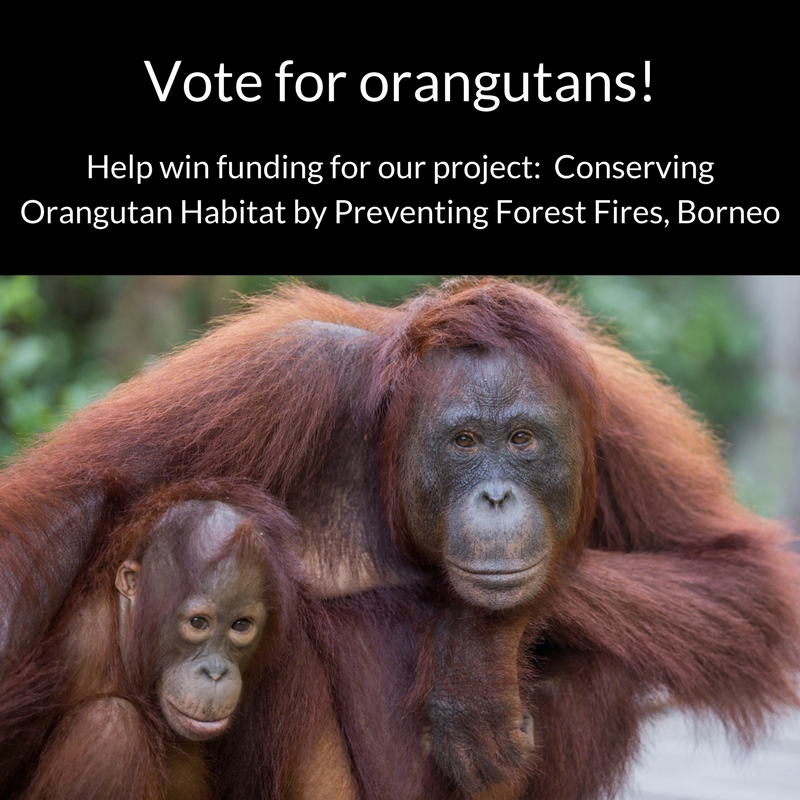 Vote for Orangutan Foundation - click here
Following a rigorous selection procedure, the European Outdoor Conservation Association (EOCA) has created a shortlist of projects to fund. We’re delighted to be one of them. It now goes to the public to decide who should receive funding! This is why we are asking for your help.
Vote for Orangutan Foundation - click here
Following a rigorous selection procedure, the European Outdoor Conservation Association (EOCA) has created a shortlist of projects to fund. We’re delighted to be one of them. It now goes to the public to decide who should receive funding! This is why we are asking for your help.
Voting runs from today, 9 March (00.01 GMT) to Friday 23 March (12.00 GMT) 2018.
If we win we will receive funding for our Project: Conserving Orangutan Habitat by Preventing Forest Fires, Borneo.The overall goal is to prevent the loss of protected peat swamp forest, habitat of the critically endangered orangutan, from fire. We know how devastating fires can be. Only last month, our staff had to battle fires around the Lamandau Wildlife Reserve. They managed to extinguish them preventing thousands of acres from going up in smoke.
The project will focus on Tanjung Puting National Park and Lamandau Wildlife Reserve, two protected areas in Central Kalimantan, which lost 103,000 hectares to fire, in 2015. EOCA funding will be used to create and distribute an awareness campaign ‘Stop kebakaran hutan dan lahan‘ (Stop forest and land fires). It will focus on the negative socio-economic impacts of fires including tourism losses and health costs.
Funding will provide annual specialist fighting fire training during the dry season to Orangutan Foundation and local authority staff. It will buy equipment for use by the Orangutan Foundation forest patrol staff in the National Park and for the villagers that are close to the Reserve, who attend the firefighting training.
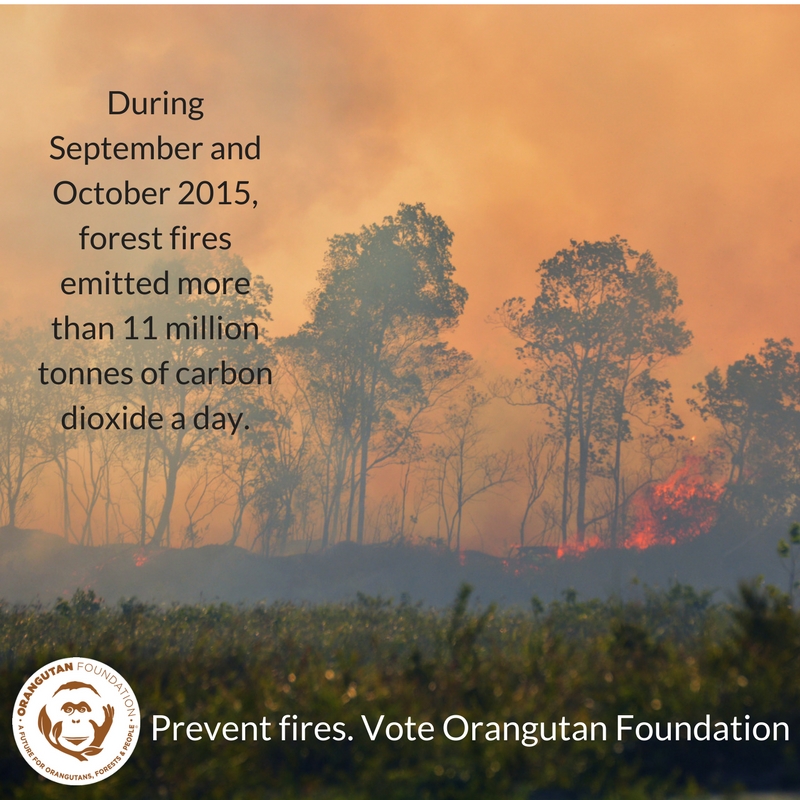
Tujuan proyek: Tujuan keseluruhan proyek ini adalah untuk mencegah kehilangan kawasan lindung hutan rawa gambut yang merupakan habitat orangutan terancam punah akibat kebakaran. Proyek ini fokus di dua kawasan lindung di Kalimantan Tengah yang pada tahun 2015 hilang 103.000 hektar akibat kebakaran. Tujuan proyek ini akan mengurangi pembakaran hutandan lahan oleh warga masyarakat dengan melakukan kampanye penyuluhan, pelatihan, dan menyediakan peralatan pemadaman kebarakan untuk instansi terkait, masyarakat lokal, dan staf Orangutan Foundation.
Dana dari EOCA akan digunakan untuk melakukan kampanye penyuluhan ‘Stop Pembakaran Hutan dan Lahan’. Kampanye tersebut akan menyoroti dampak negatif kebakaran terhadap sosial-ekonomi termasuk kerugian wisata, serta biaya kesehatan. Proyek ini akan mengadakan pelatihan khusus pemadaman api pada musim kemarau dan pembelian peralatan yang dibutuhkan staf lapangan untuk memadamkan api di dua kawasan hutan tersebut, yang merupakan habitat orangutan.
Orangutan Foundation Poster Competition Winners Announced!
Today is World Wildlife Day and so is perfect timing for us to announce the winning posters of our competition 'The Orangutan's World'!

Our annual competitions never fail to disappoint. Whether it is posters, designing T-shirts, cakes or writing stories, every year we receive hundreds of entries from talented young people, demonstrating their knowledge about wildlife and how much they care.
This year we were delighted to have wildlife artist, Gary Hodges and our patron, wildlife TV presenter, Patrick Aryee as our judges. On Thursday, they trudged through the snow to our HQ, where they had the unenviable task of judging hundreds of wonderful posters. Over to judge, Gary Hodges, for his feedback on the competition...
'On the huge table before us were displayed hundreds of artworks from supporters of the Orangutan Foundation. No ordinary supporters though, they were all drawn from the wild imaginations of children and young teenagers. The TV presenter Patrick Aryee and I certainly had our work cut out.
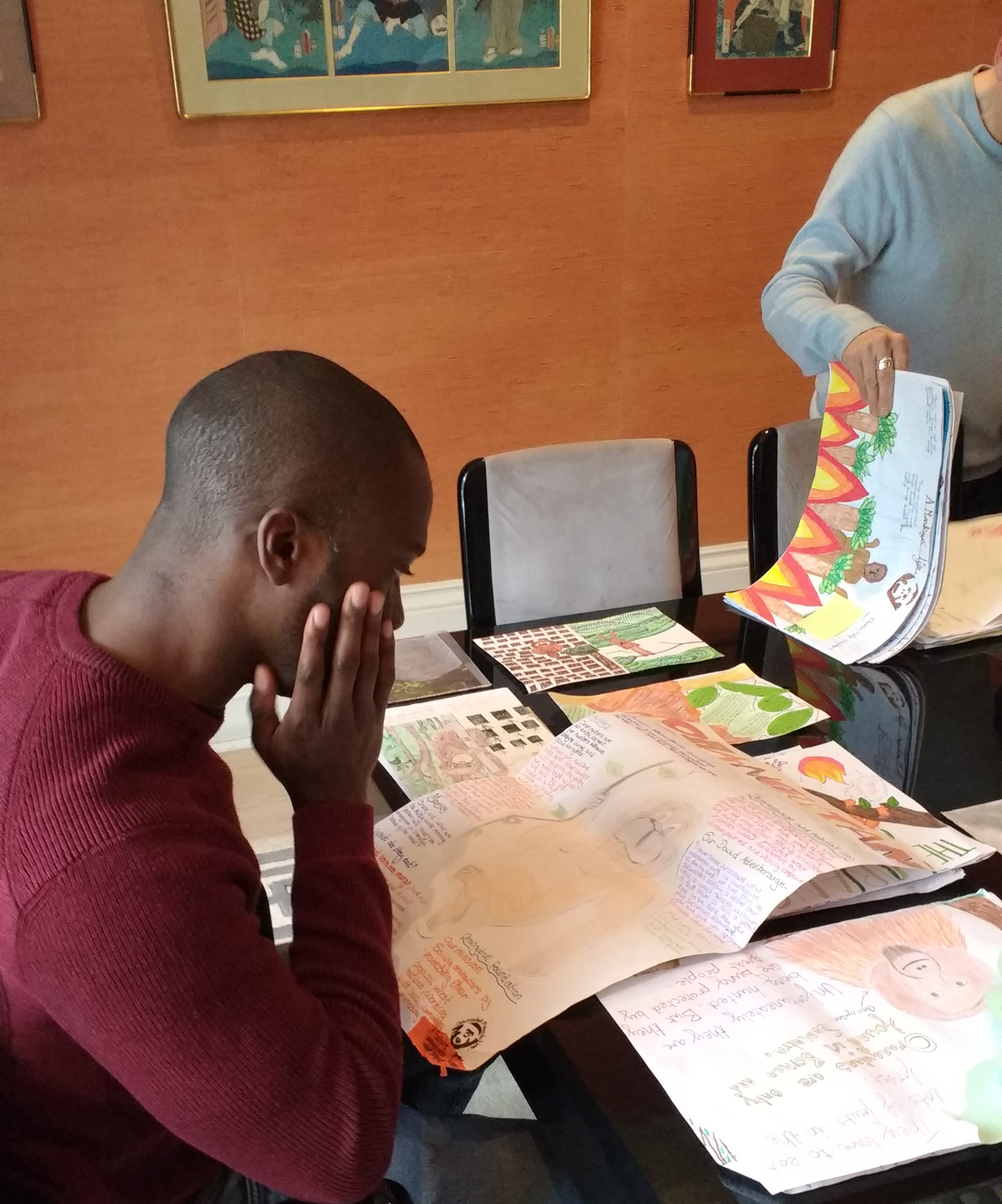
A couple of hours and lots of head scratching later, we had whittled it down to twenty five best ones. Eventually we picked our absolute favourites and they were all so good we decided to give five rather than three top prizes to these worthy winners. A further bunch of great poster people received highly commended prizes too. What a lovely day!'
The overall winner was Alana Quinn. Both judges felt Alana's poster showed great skill and really stood out. Alana's prizes include a signed Gary Hodges print of 'Majesty' Royal Bengal Tiger, Faber Castell art material and the photobook, The Orangutan's World - a photographic celebration of Bornean wildlife.
Here are the fabulous runner up posters:
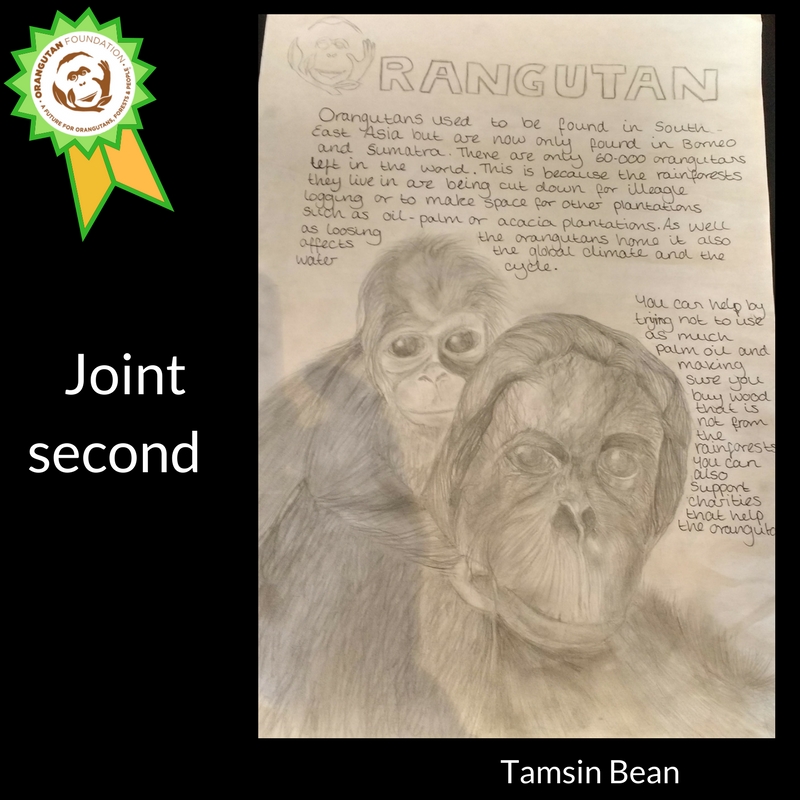
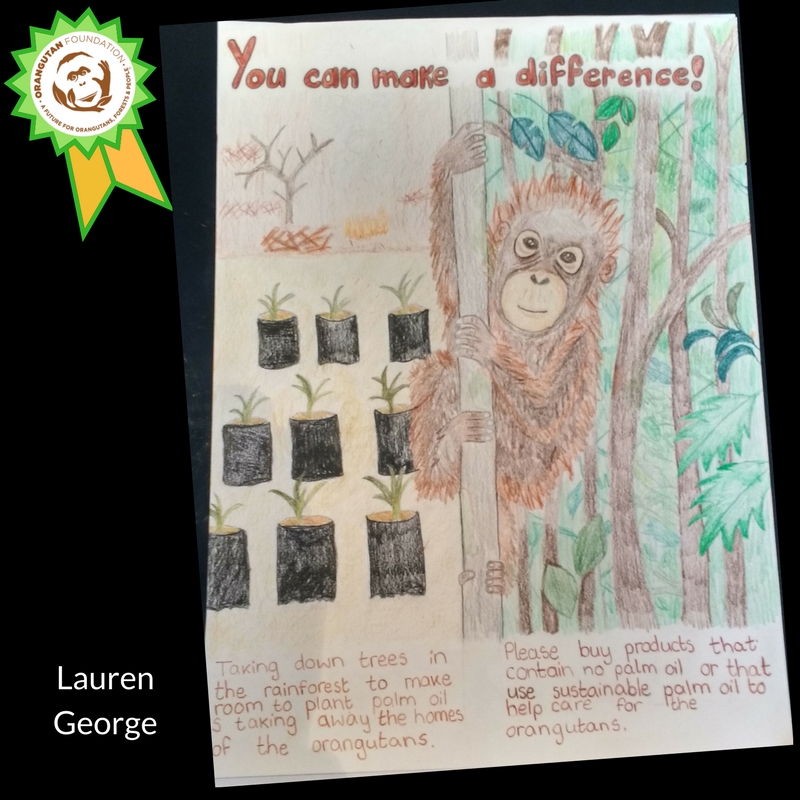
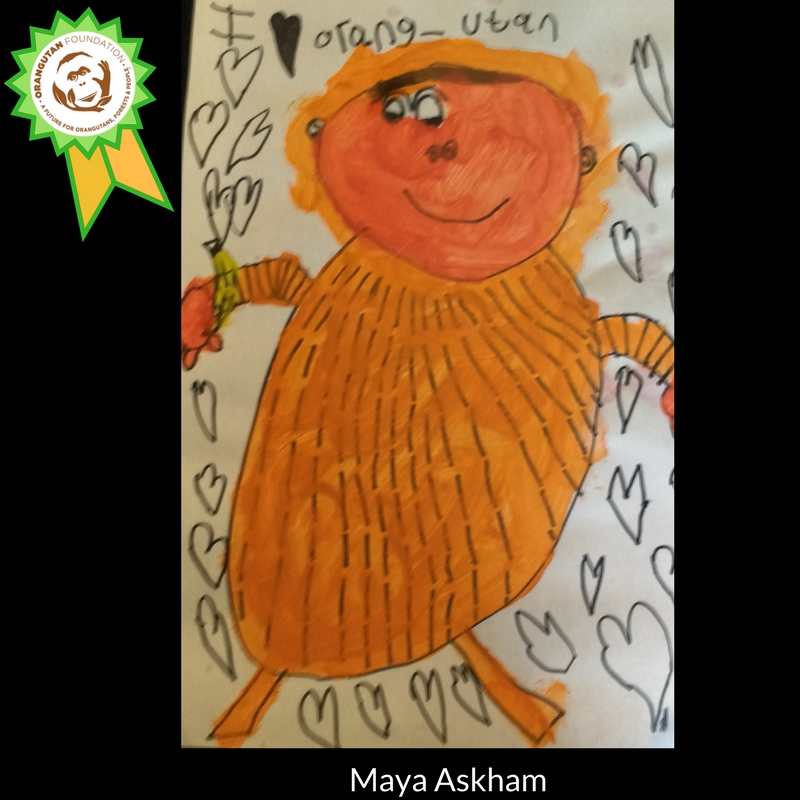

Gary is also donating a selection of his postcard books to 20 highly commended posters.
A big thank you to all the children who entered and did their bit for orangutans. Thank you to our judges, Gary and Patrick. Thank you to Gary Hodges, Faber Castell and Usbourne Books for the prizes and to Animals and You magazine for helping to publicise the competition.
Do something for wildlife today!
"All my days in the field are special, but on occasion something really exciting happens - a fight between two male orangutans and we were able to film it." - Ashley Leiman OBE
No sooner had our speedboat arrived at Camp Buluh when the staff came running and excitedly told us to hurry up. I knew before I reached the end of the jetty by the noise of breaking branches that something was going on in the forest ahead.
It didn’t take me long to see one huge male being pursued by another, both cheek padded. The assistants told me that they were Yoko, who was often seen around Camp Buluh, and Darwin, who hadn’t been seen for a number of years.
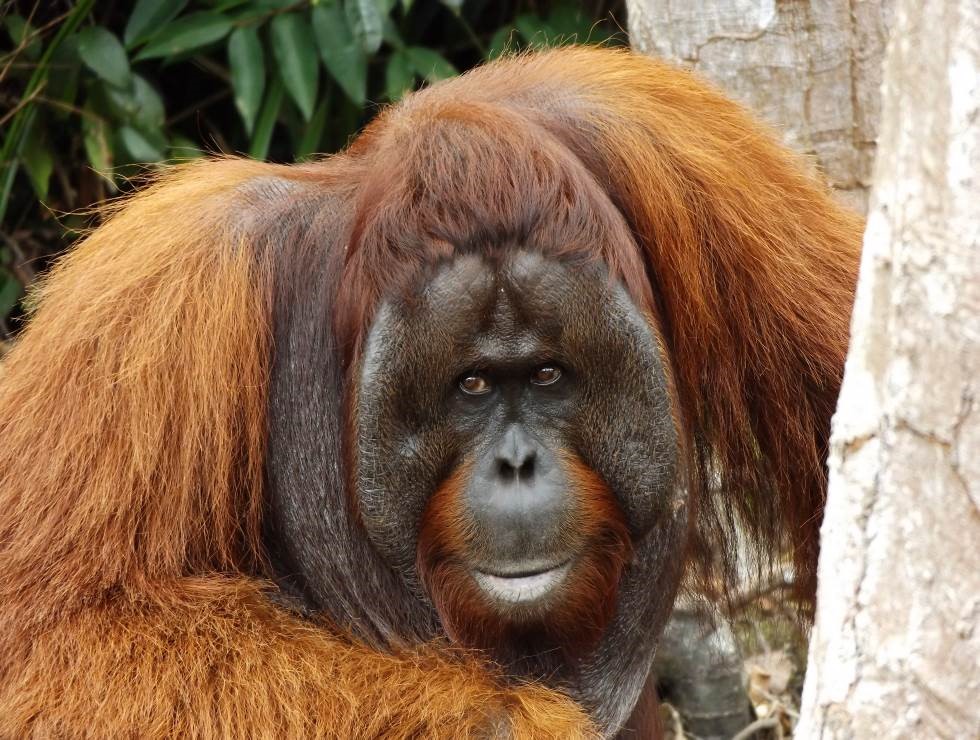
The orangutans were face-to-face in open combat. They would grapple one another, no doubt inflicting some injuries. This would last for a number of minutes until one would go further into the forest and there would be a lull in the confrontation.
There were times when both came down to the ground, one aggressively pursuing the other, before going back up into the trees. What was interesting was that during the conflict they would occasionally stop to rest, so obviously this activity takes a lot of energy.
Long calls and branch cracking perforated the performance. This encounter went on for over two hours before Darwin, realising Yoko had the upper hand, made his way further into the forest and was not followed. That’s what I love being in the field, it’s never boring, it’s not every day one sees such excitement.
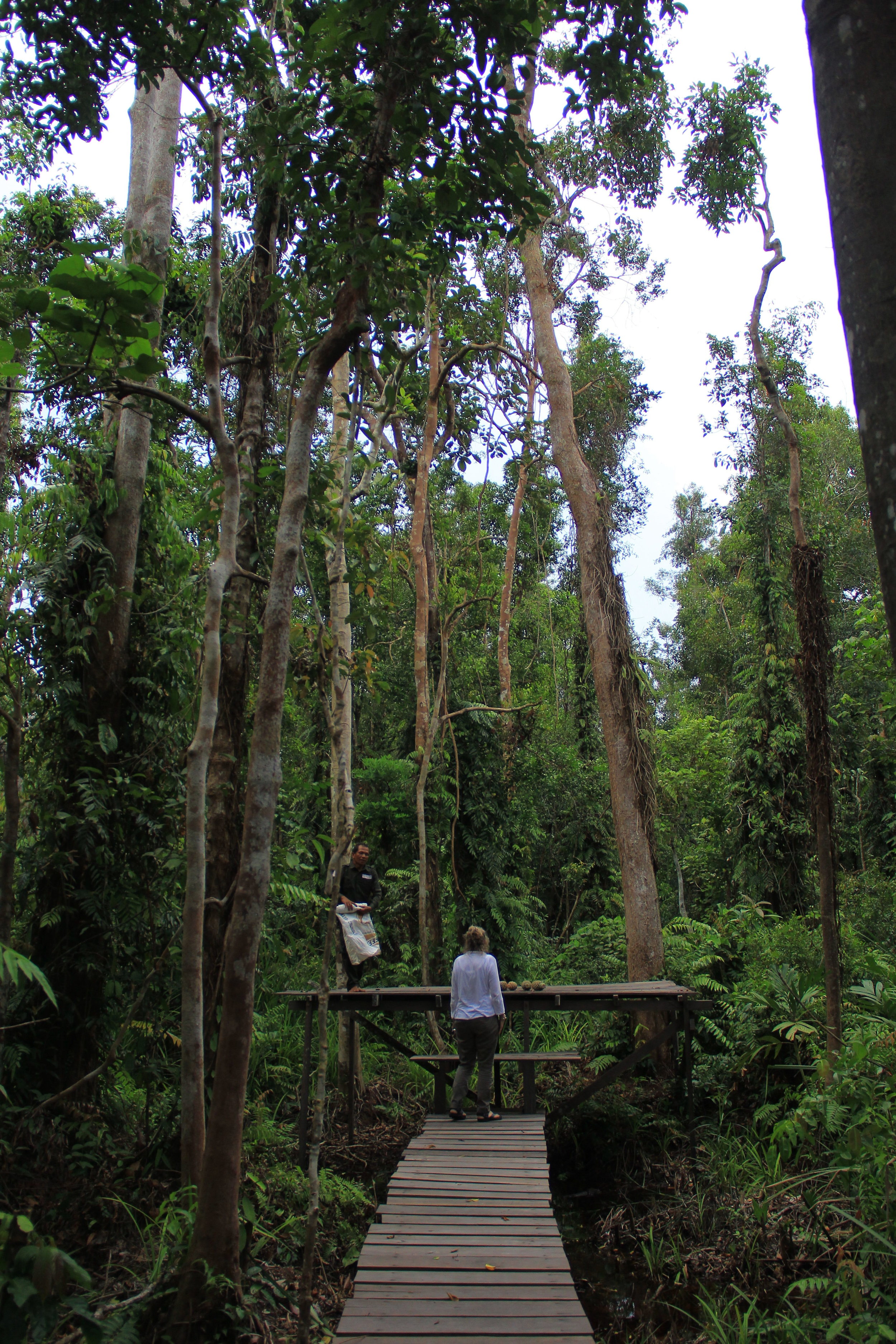

Become a Guardian of Lamandau today and help us protect the home of Yoko, Darwin and over 500 other critically endangered orangutans. Click here to find out more.
Thank you.
Ashley Leiman OBE, Director
Have your donation doubled for free and support Borneo's wildlife conservationists
From 28th November until 5th December you can DOUBLE your donation through the Big Give Christmas Challenge, at no extra cost to yourself. Click here to donate and double your impact to support our work. This year our we are raising funds to inspire Borneo’s future conservationists. In this clip Arie, Research Manager of Pondok Ambung, our tropical forest research station in Tanjung Puting National Park, explains why it is important.
We use camera traps to monitor the wildlife in the forests surrounding Pondok Ambung. Watch this short clip to see some of the species we’ve managed to capture on film!
To protect Indonesia’s biodiversity, future conservationists need to be encouraged and supported.
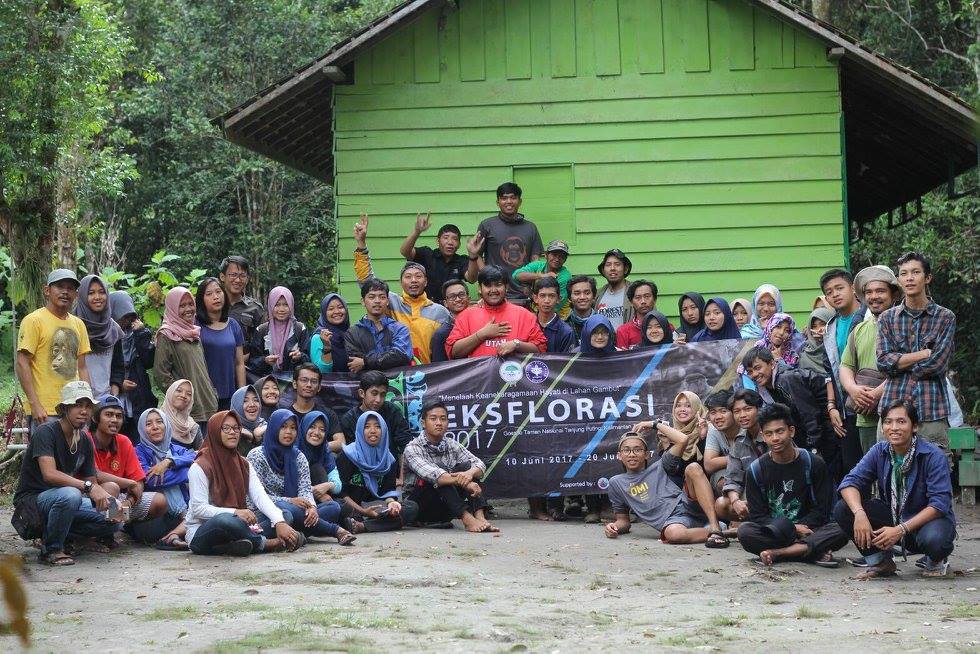
Our research station is a base from where Indonesian students and international scientists can conduct research. Take a virtual tour below:
Please help us to ensure a future for orangutans, forests and people.
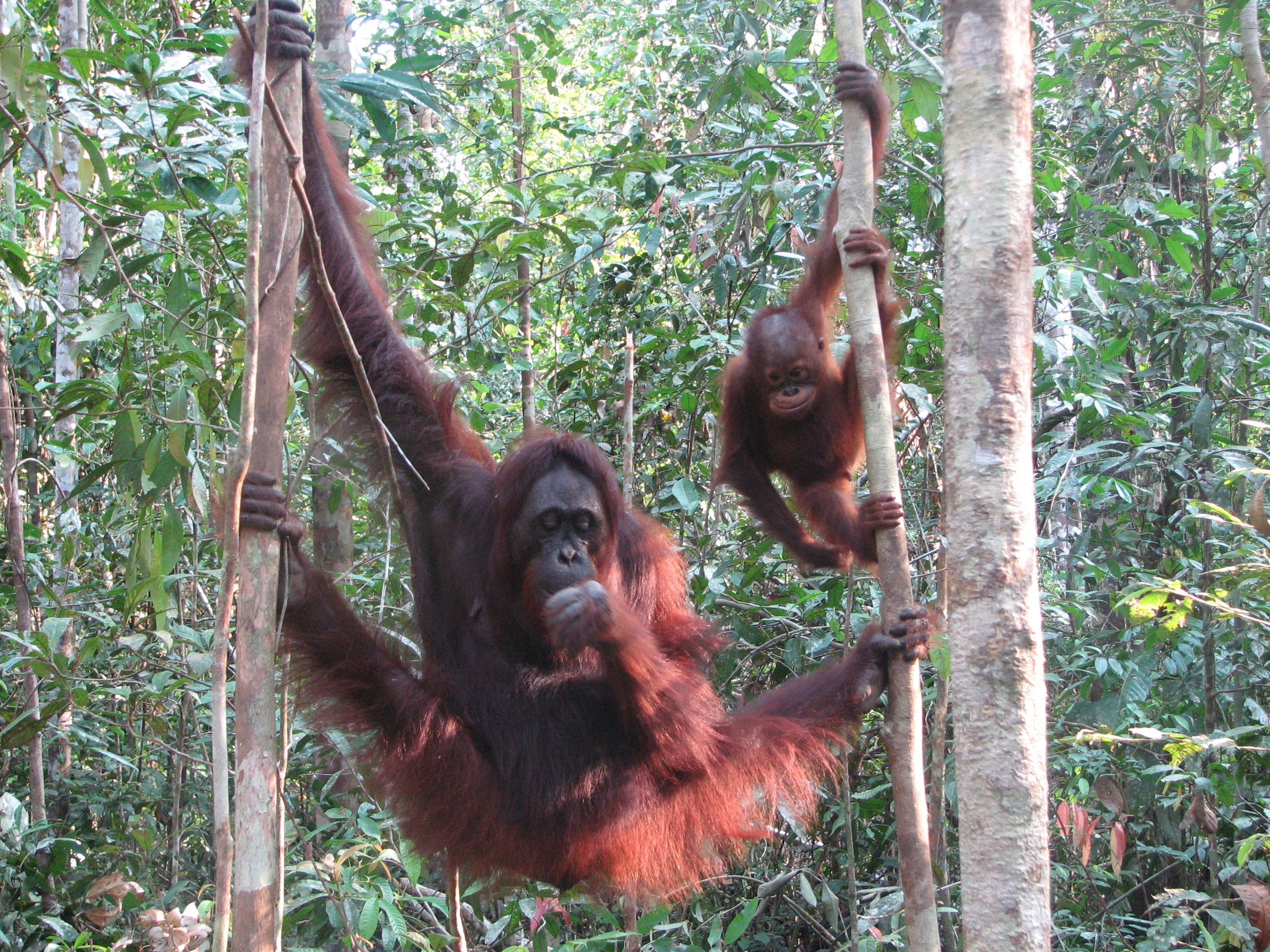
Thank you for your support. Click here to DOUBLE YOUR DONATION through the BIG GIVE.
